

Find your path to meaningful work.
Work in environment, sustainability, climate action.
Photo by Damir Babacic on Unsplash



Find your path to meaningful work.
Work in environment, sustainability, climate action.
Photo by Damir Babacic on Unsplash
Welcome to another issue of Saving Earth Magazine!
In this edition, we look at the change makers—environmental organizations that are defending the planet, green businesses that are putting environment before profit, and those who are paving the way to a better future for us all. There is no greater time than now to get involved in saving the planet.
This summer, Canadians experienced extreme, record-breaking temperatures, drought, and relentless fires. Climate change is happening now, and yet old-growth trees (natural carbon sequesterers) are still being clear-cut in British Columbia. This lack of responsibility by elected officials must come to an end. We don’t need to read about climate change anymore; we can see it with our own eyes. We can feel it.
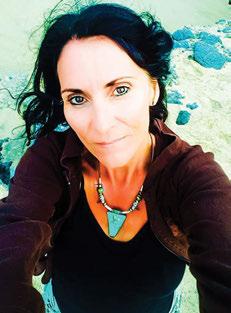 Teena Clipston Publisher & Editor-in-Chief, Saving Earth Magazine
Teena Clipston Publisher & Editor-in-Chief, Saving Earth Magazine
The town of Lytton, BC, not only saw a record temperature of 49.6 degrees C for three days in a row, but the village also nearly burned to the ground because of uncontrollable fires. In British Columbia alone, 486 deaths were attributed to a five-day heatwave that swept the west. According to Statistics Canada, crops are in decline because of drought and hot weather. And, if that wasn’t enough, sockeye salmon were being cooked alive in over-heated waterways like the Columbia River.
In an attempt to once again sound the alarm, the Intergovernmental Panel on Climate Change (IPCC) has released another report on August 9 declaring a code red for humanity. Greenhouse gas concentrations are at record levels, and the earth’s temperature continues to rise. There is only one humane solution to this problem and that is to transform our fossil fuel dependency into green energy now. Surely, if the governments of the world can invest billions of dollars into the COVID pandemic emergency, they can do the same for green energy.
I encourage you to support the organizations and businesses that are doing their best to make a difference. In this edition, find out who is saving our oceans, who is making a difference, which businesses are focusing on sustainability, and more. When we support non-profits, volunteer groups, and organizations with environmental mandates, we are showing the government what we care about, influencing our communities to take up the cause, and ensuring our lives are rich and fulfilling because we know we have stepped in the right direction. The time is now. Get involved.
Wishing you all the very best,
Teena ClipstonBY Saving Earth
Teena Clipston
EDITOR Cassie Pearse
EDITOR Jessica Kirby
EDITORIAL ASSISTANT Carolyn Rapanos
GRAPHIC DESIGN Cassandra Redding
GRAPHIC DESIGN ASSISTANT Iveta Lekesova
ADVERTISING Teena Clipston CONTRIBUTORS
Carolyn Rapanos, Jay Clue, Lucero González Ruiz, Sierra Club BC, Dina Ni, Sergio Izquierdo, Brenna Two Bears, David Suzuki, Jan Lee, Erin Blondeau, GreenStep Solutions & Partners, Minto Roy, Roslyne Buchanan, Teena Clipston, Kayla Bruce and Shayne Meechan.
PRINTING
Royal Printers
DISTRIBUTION
Magazines Canada & Royal Printers
COVER PHOTO
Steve Halama
Saving Earth Magazine has made every effort to make sure that its content is accurate on the date of publication. The opinions expressed in the articles are those of the author(s) and do not necessarily reflect the opinions of the publisher or editor. Information contained in the magazine has been obtained by the authors from sources believed to be reliable. You may email us at Saving Earth Magazine for source information. Saving Earth Magazine, its publisher, editor, and its authors are not responsible for any errors, omissions, or claims for damages, and accept no liability for any loss or damage of any kind. The published material, advertising, advertorials, editorials, and all other content is published in good faith.
©Copyright 2021 Saving Earth. All rights reserved. Saving Earth Magazine is fully protected by copyright law and nothing herein can be reproduced wholly or in part without written consent.
PRINTED IN CANADA
savingearthmagazine.com
info@savingearthmagazine.com
Phone: 250-754-1599
facebook.com/savingearthmag
Instagram: @savingearthmag
ISSN 2563-3139 (Print)
ISSN 2563-3147 (Online)
Library and Archives Canada, Government of Canada



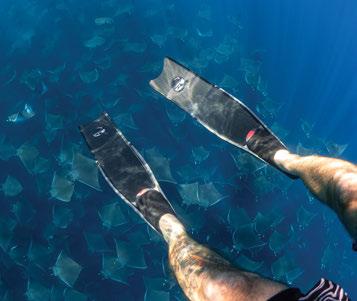
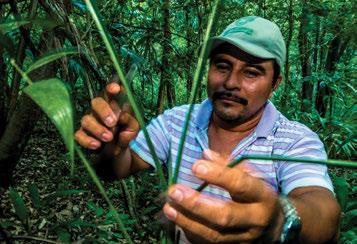
Eight essential Canadian organizations dedicated to protecting this precious resource.

Keeping our oceans healthy is an urgent and complex issue that requires a diversity of approaches. In response, we put the spotlight on some essential Canadian organizations dedicated to this work. Their reach ranges from local communities to international networks, and their members range from volunteers to experts. Removing ocean pollution is a big focus, but these organizations also concentrate on protected areas, Indigenous rights, research, and restoration. They demand improvement from governments, industries, and communities, and provide the science-based leadership required. We contacted them to learn more about what they do and why they do it.
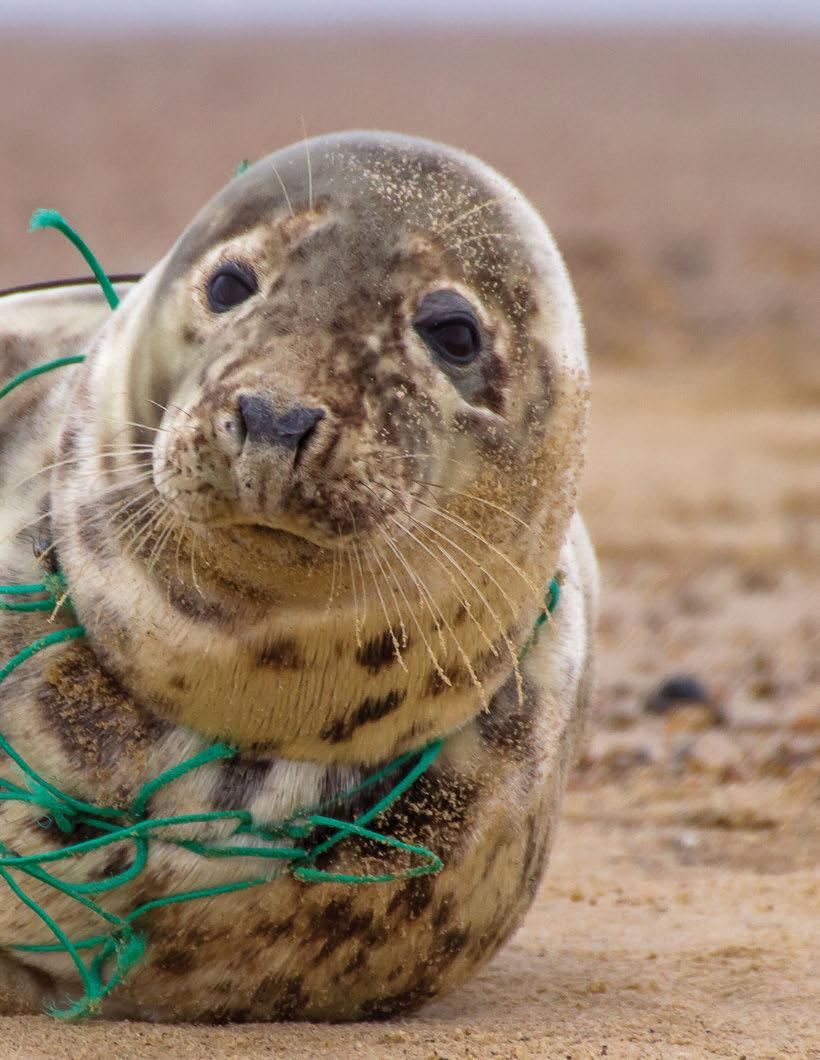
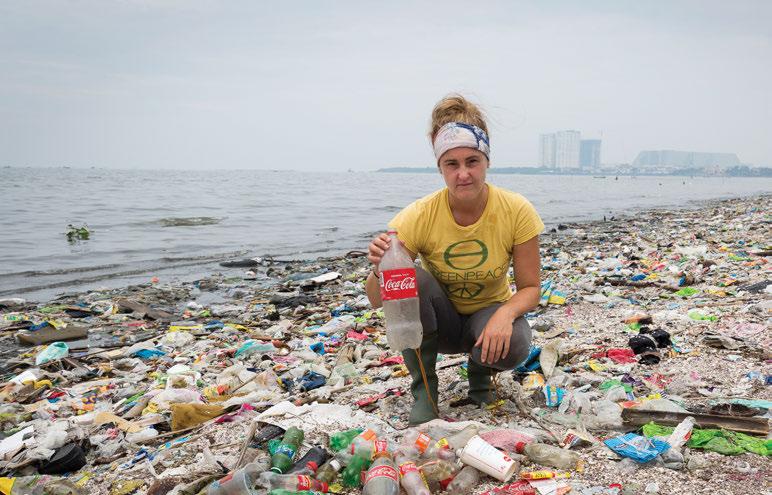
“The cornerstone of Canada’s zero plastic waste plan is recycling without an explicit commitment to eliminating single-use plastics wherever possible. Without first reducing the amount of plastic waste being generated, we cannot possibly succeed in preventing pollution simply due to sheer volume. Even one percent of plastics that escape collection translates into more than 150,000 tonnes of plastic in Canadian landscapes and waterways each year.
“The plan’s reliance on recycling also enables sustained virgin plastic production, continued reliance on fossil fuel extraction for that production, and unaccounted-for carbon emissions from extraction to end of life. Plastic cannot be recycled indefinitely and must eventually be disposed of. Unfortunately, the plan’s definition of 'recycling' includes incineration (also referred to as 'chemical' or 'advanced' recycling when energy is captured from the process), which clearly does not conform to the general notion of making reusable materials from waste.
“Ultimately Canada’s zero plastic waste plan lacks strategies that will eliminate plastic waste and instead focuses on cleaning up the mess at the expense of our ecosystems and climate.”
– Greenpeace Canada.
Since its first voyage 50 years ago on Alaskan waters, Greenpeace has reached far beyond its Pacific Northwest origin.
Throughout its existence, Greenpeace has called on corporations to reduce their plastic footprint and stop producing packaging that is designed for limited use before ending up in landfills, incinerators, and the environment. Greenpeace also works hard to address other serious ocean threats. Unsustainable industrial fishing destroys habitats and endangers countless species. Climate change and ocean acidification due to the reliance on fossil fuels have increasingly extreme impacts on ocean health. Today, overfishing and bycatch kills about 63 billion pounds of marine animals every year, and human activity disrupts the balance of marine ecosystems across the globe.
One of Greenpeace International’s ships, The Arctic Sunrise, recently completed a four-month voyage in the Indian Ocean to investigate destructive fishing and conduct critical research in unique ecosystems. As part of the Vital Ocean Voices project, Greenpeace International worked with coastal communities in Mauritius, Madagascar, and the Seychelles, offering grants to individuals and local NGOs for first-hand accounts of destructive fishing, pollution, and climate breakdown. The incredible results came in all shapes and sizes—writing, videos, animations, and even a poem.
Greenpeace is also working to protect the oceans through a network of sanctuaries. Globally, less than two percent of ocean is protected. Greenpeace is campaigning to establish sanctuaries for 30 percent of the world’s oceans by 2030.

Ocean sanctuaries can help with both social justice and environmental protection. Largescale ocean protection and ensuring international waters don’t become a new 'wild west' for corporations will secure livelihoods and food security for millions. Healthy oceans support people, save wildlife, and tackle climate change.
Here at home, Greenpeace Canada’s ocean protection work resulted in a plastics campaign. Canada is surrounded by seawater, and reducing or eliminating plastic waste that leaks into the environment is a top priority. www.greenpeace.org/canada/ en

“Home to more than 13,000 kilometres of coastline, Nova Scotia is at risk from the effects of climate change. Clean Foundation is in the race to protect them, working to improve coastal habitats through natural approaches, restoration, and adaptation methods. As part of the Department of Fisheries and Oceans’ Coastal Restoration Fund, they work collaboratively with a variety of diverse partners to identify, assess, monitor, and restore salt marshes along the Northumberland coast.
“According to Charlynne Robertson, manager of the Clean Coasts program, salt marshes are vital to help stabilize our coasts, buffer against storms and floods, store carbon, filter water, and are home to many species of plants, fish, and wildlife. They are also culturally important to the Mi’kmaq.
“Some restoration methods include promoting tidal movement by building bridges, digging runnels, and using nature-based approaches to shoreline management.” – Clean Foundation Clean Foundation is a non-profit environmental charity that provides trusted information and takes action on climate change solutions in Atlantic Canada. They provide the knowledge, tools, and inspiration needed to encourage the actions that lead to positive environmental change.
Clean Foundation works in the ancestral and unceded territories of the Mi’kmaq and Wolastoqiyik.
The organization works collaboratively with many partners to reduce energy poverty, promote social equity, support historically marginalized communities, and to develop the clean economy workforce, protect the natural environment, and educate and promote action on climate change.
Clean Foundation works to assess, monitor, and restore coastal habitat. They work with partners to share knowledge and skills through training and volunteer opportunities so they can collaboratively achieve viable climate solutions. www.cleanfoundation.ca
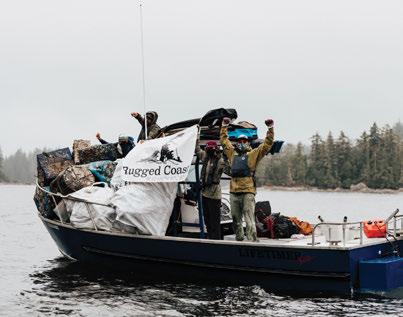
“The first step to solving a problem is identifying that there is a problem.
“Coastline mapping of marine debris is part of this identification process. In order to be as efficient and effective as possible during clean-up efforts, there needs to be a comprehensive data set. If we wish to see our resources go as far as possible in remediating marine habitats affected by ocean debris, we need this information to act accordingly.
“Rugged Coast began mapping the west coast of BC in 2017, and in that time, we have identified many 'hot spots' of debris accumulation, and have used this information to guide both our clean-up efforts and those of other organizations. This data has enabled the removal of over 100,000 kilograms of debris from our coastlines this year alone (2021).
“Mapping may not be the visually stunning or story-building work of cleaning up, but it plays a vital role in the success of these programs. Mapping our coastlines is key to protecting what we love—our oceans.”
– Rugged Coast Research Society
Rugged Coast Research Society (RCRS) is a firm believer in giving back to the natural playgrounds that have given us so much over the years. Formed in 2017, RCRS is comprised of marine industry professionals, marine biologists, and entrepreneurs working together to research the impacts of marine debris and restore the most remote coastal areas. Partnering and sharing their data with stakeholders, they are committed to working collaboratively to better the marine environment we all depend on.
2021 has been a great year for RCRS. Provincial government funds have been released to facilitate the arduous task of cleaning coastlines of marine debris and derelict vessels. Rugged Coast is managing and executing five remoteshoreline clean-up projects within this fund: Hesquiaht Peninsula, Brooks Peninsula, Kyuquot First Nation, Nootka Island, and Deer Group Archipelago. From these five large-scale operations, they expect to remove well over 100,000 kilograms of marine debris from ecosystems. This is a step in the right direction, although this will only impact a tiny fraction of the issues we face. www.ruggedcoastresearch.com
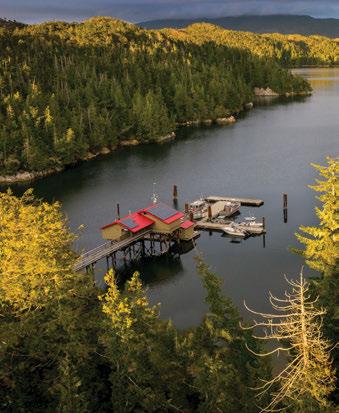
“The whole coast is connected, beginning from high in the mountains and flowing toward the ocean. Ice in glaciers and seasonal snowpack comprises what is known as the cryosphere—a frozen reservoir of water that, when it melts, produces massive amounts of fresh water. This freshwater transports vital nutrients that fuel the base of ocean food webs through coastal watersheds and out to the ocean.
“Climate change is reshaping the cryosphere, especially the amount and timing of water flow during the spring melt. Such changes have considerable implications for salmon, both when they return to spawning grounds and on their way out to the ocean when they’re young. Throughout British Columbia, the Hakai Institute and its collaborators keep tabs on the cryosphere year-round using technologies ranging from satellites to airplanes to drones to in-the-field measurements.” – Hakai Institute
The Hakai Institute—part of the Tula Foundation—is based within the diverse coastal habitats of British Columbia, Canada. The Hakai Institute represents what happens when the elements of funding, infrastructure, science programs, skilled staff, and partners are integrated into one organization.
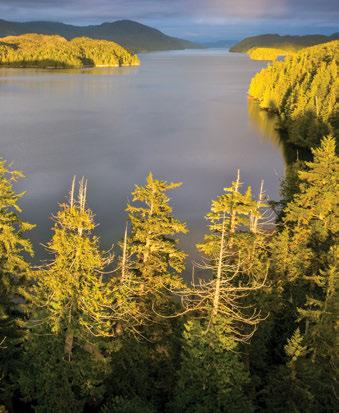
Their first ecological observatory is a converted fishing lodge on the Central Coast of British Columbia on Calvert Island, which has been operating for more than a decade. In 2014, they opened their second ecological observatory at the northern end of the Salish Sea on Quadra Island. They also have offices in Campbell River, Victoria, and Vancouver.
The Hakai Institute used their facilities and resources to create a huge network of collaborators from universities, government agencies, First Nations, NGOs, and local communities. Their collective efforts have catalyzed an enormous quantity of science, education, and stewardship.
Their scientific scope encompasses the entire coastal margin, from the coastal ocean all the way up to the ice fields, and the many linkages between ecosystems therein. Their science crosses the continuum from ocean physics and chemistry to coastal ecology, and extends through deep time with archaeology. Increasingly, they’ve added expertise in technologies such as sensor networks, geospatial mapping, information technology, and computer modeling. www.hakai.org

“An ocean plastic depot is a drop-off location for marine debris such as Styrofoam, tires, hard plastic from aquaculture industries, single-use plastic, rope, netting, buoys, and foam floats that accumulates on shorelines. Materials at these depots are then regularly shipped to the Ocean Legacy Marine Debris Recycling Facility in Vancouver where material such as rope and plastic are remade into pellets that can be recirculated into the plastic economy. Ocean depots are a crucial part of protecting our oceans because they provide a recycling solution to the massive amount of consumer plastic and industrial waste that regularly ends up on beaches and harms the environment and surrounding ecosystems.” – Ocean Legacy Foundation
The Ocean Legacy Foundation (OLF) is a Canadian-based, internationally recognized non-profit organization that has developed a world-leading Plastic Pollution Emergency Response™ program called EPIC. Below are the four components:
Education and Research: OLF believes worldwide change begins with dedicated and well-informed individual action. Everyone needs to understand the problem and potential solutions, and this knowledge will drive innovation and changes to the global plastic pollution emergency.
Policy and Advocacy: Policy is about merging best-practice plastic management strategies with the needs of communities and the health of the planet. OLF continuously advocates for creating better programs, practices, and policies, both locally and globally.
Infrastructure Development: Plastic pollution is a result of waste mismanagement and the over-consumption of plastic. Many countries, including Canada, lack adequate infrastructure to manage waste, resulting in materials being discarded inappropriately and ending up either in landfills or in the ocean. The Marine Debris Recycling Facility is one of Canada’s first and only recycling facilities and is anticipating accepting over 600 tonnes of marine debris collected from coastlines around BC over the next four months.
Clean-up: Both consumer and industrial waste collects along shorelines, and clean-ups are needed to remove plastic pollution from these ecologically sensitive environments. Clean-ups provide opportunities for citizens who witness or deal with plastic pollution in their hometowns to partake in action-based campaigns. A recent clean-up began in May 2021 and was funded by the Province of BC Clean Coast Clean Water Initiative Fund. OLF partnered with over 30 groups and First Nations to remove over 70 tonnes of debris from 3000 kilometres of coastline in the BC Central Salish Sea. www.oceanlegacy.ca

“Indigenous protected areas (IPAs) are a relatively new model for conserving the health of our planet, although in practice they’ve been around for a long time. Creating an IPA is partly just formally acknowledging the stewardship Indigenous Peoples are already engaged in. Despite making up only five percent of the world’s population, Indigenous Peoples protect over 80 percent of the world’s biodiversity. IPAs are also about addressing the flaws in earlier models of conservation. In Canada and elsewhere, conservation has often meant displacing Indigenous Peoples or preventing them from harvesting traditional foods. By contrast, IPAs are about protecting places for people rather than from people. Indigenous peoples have a leading role in the stewardship and management of these areas and continue to harvest sustainably, benefitting from their lands and waters. The environment then prospers under the supervision and care of the people who are most invested in its health.” – Oceans North
Oceans North supports marine conservation in partnership with Indigenous and coastal communities. They work to address the unprecedented environmental changes taking place in northern marine ecosystems and ensure that these regions are protected within the framework of Indigenous knowledge, rights, and consultation.
Oceans North began with the premise that one of the most impactful things conservationists can do is support communities that depend on a healthy ocean environment and are already working to protect it. In the Arctic, a significant amount of important marine habitat is located next to the communities that make up Inuit Nunangat, the traditional Inuit territories that
stretch from the western Arctic to the north coast of Labrador. Like many Indigenous peoples, the culture and livelihoods of Inuit have traditionally been tied to their lands and seas. Their first projects began in this region, assisting communities in long-term protection of the marine environment. While Oceans North has expanded its work to other parts of the country, they remain committed to the idea that effective conservation strategies begin with local partnerships and respect for cultural and societal well-being. Helping to create marine protected areas with strong oversight— and ensuring that these areas are held to a high standard of protection—is an important part of their job. Oceans North works with communities, industry, and different levels of government to help provide information and capacity for identifying and creating such areas. Oceans North also works to manage the impacts of industries such as fishing and shipping on a broader scale, across the Arctic and Atlantic oceans.
Although much of their work is area-specific, they recognize that the ocean and climate are part of one large, interconnected system. With that in mind, they have begun to take on projects that have a global reach. These include reducing emissions from the shipping industry, preventing irresponsible mining in the deep sea, and pushing for a new treaty to govern biodiversity in the high seas.
www.oceansnorth.org/en
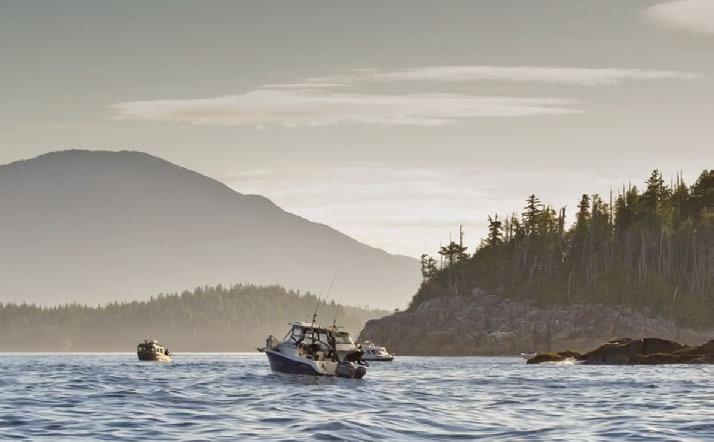
“The Pacific North Coast Integrated Management Area (PNCIMA) is an agreement creating a collaborative model for ocean governance that ensures First Nations’ meaningful participation in the development of marine-use management plans for the North Pacific Coast. In 2017, First Nations, Canada, and British Columbia fully endorsed the PNCIMA plan, which sets broad goals and strategies for the management of more than 100,000 square kilometres along the coast of the Great Bear Rainforest. The plan is a high-level and strategic commitment to integrated, ecosystem-based, and adaptive management of marine activities and resources in the planning area.
“The goals of PNCIMA are as follows: integrity of marine ecosystems, primarily with respect to their structure, function, and resilience; human well-being supported through social, economic, spiritual, and cultural connections to marine ecosystems; collaborative, effective, transparent, and integrated governance, management, and public engagement; and improved understanding of complex marine ecosystems and changing marine environments.”
- Coastal First Nations-Great Bear Initiative
Coastal First Nations-Great Bear Initiative (CFN-GBI) is a unique alliance of First Nations from the North and Central Coast and Haida Gwaii. They include the Council of the Haida Nation, Skidegate, Old Massett, Metlakatla, Gitxaala, Heiltsuk, Nuxalk, Gitga’at, Kitasoo/Xai’Xais, and Wuikinuxv First Nations.
CFN-GBI promotes community self-sufficiency and sustainable economic development for all member First Nations, each of which is committed to working together to build a strong, conservationbased economy that recognizes their Title and Rights, and protects their culture and ecosystems.
The Great Bear Rainforest, made up of coastal mountains, lush valleys, and interlocking waterways, forms the largest and most intact coastal temperate rainforest in the world. Influenced by the ocean and abundant rainfall, the region supports some of the most biologically diverse ecosystems on Earth. For CFN-GBI member First Nations, protecting these coastal ecosystems is a life-long responsibility.
As a coastal people, they know that keeping ocean ecosystems healthy is the key to preserving their culture, food security, and economic self-sufficiency. Their connection to the ocean defines who they are: killer whales, salmon, eulachon, and other iconic marine species feature in their traditions, ceremonies, stories, and songs, which are passed from one generation to the next. Ancient village sites and important cultural sites in the Great Bear Sea are evidence of a vital marine culture dating back thousands of years. These communities support sustainable planning initiatives for ocean resources, including collaboration with government, industry, environmental groups, and others, and ongoing efforts to create a network of marine protected areas (MPAs). cwww.oastalfirstnations.ca
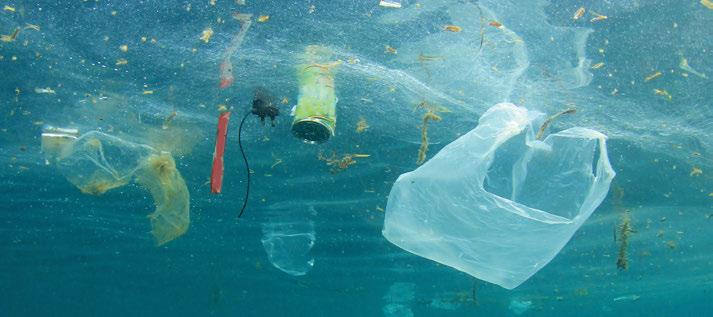
“There are many ways to mobilize the community to reduce their plastics. One of the most impactful ways, especially in our increasingly virtual world, is through story-sharing on social media. Oftentimes when things are out of sight, they are out of mind. By sharing how big and far-reaching our plastic pollution problem is, we are increasing awareness that this issue is not caused by any one person, business, or place. It is a collective issue that we all must work together to solve. Aside from allowing us to share how bad the problem is, social media can spread quick tips for ditching plastic and finding more sustainable alternatives. If social media isn’t your thing, simply talking about the impacts of plastic pollution within your community through a solution-focused lens (not a judgemental one), and making small changes whenever possible can empower us all to eliminate plastic from our lives.”
Plastic Oceans Canada is about to launch their Circular Economy Ambassador Program, which aims to engage students across Canada in not only cleaning our shorelines, but learning about how to deal with what has been collected. Participants will track and analyze data, and learn about the importance of shifting away from single-use plastics towards an economy where items are constantly being reused and repurposed.

Plastic Oceans Foundation Canada was established in 2016 as a non-profit organization and a registered Canadian charity. It is part of a global organization with offices in the United States (global headquarters), Chile, Mexico, and Europe.
Plastic Oceans Canada’s mission is to inform, inspire, and incite action to solve plastic pollution through its four pillars: activism, advocacy, education, and science. Plastic Oceans Canada creates change by supporting and implementing programs to clean our coastlines, advocating for Canadian businesses to take impactful steps towards eliminating their plastic footprint, educating the public on plastic pollution, and creating community involvement.
Plastic Oceans recently launched its BlueCommunities program, an international initiative that operates with one very simple belief—that we can and must act locally to inspire and create change on a global scale. This program established long-term egalitarian relationships with partners working on projects in their communities that embrace circular principals. We believe that these localized efforts are the building blocks for creating socioeconomic and environmental change that leads to a healthier planet and more equitable society. In 2021, we identified over 20 communities and partners worldwide from Canada all the way to Cameroon, Africa, to Pune, India, to the Galapagos Islands. Our localized Canadian BlueCommunities are Mahone Bay, Nova Scotia (in partnership with Coastal Action), and Georgian Bay, Ontario, (in partnership with Georgian Bay Forever). Both organizations focus on cleaning up their local waterways as well as educating the public on conservation issues to reduce plastic pollution. www.plasticoceans.ca
The well-being of our oceans relies on the efforts of these organizations. Learning more about their work can lead to stronger support and, in turn, more effective solutions. We thank them and would also like to acknowledge Ocean Ambassadors Canada and Ocean Wise for their contributions in protecting oceans. Please consider reaching out to one of the organizations we’ve covered to learn more, donate, or volunteer.



The Pontus mission is to provide the world with environmentally sustainable pure plant-based protein.








Pontus technology is reinventing agriculture to deliver new sources of plant protein, grown in a network of biosecure indoor aquaponic farms. We make it easy to eat healthier and more sustainably.

We know very little about these mobula rays, but what we do know brings much cause for concern.
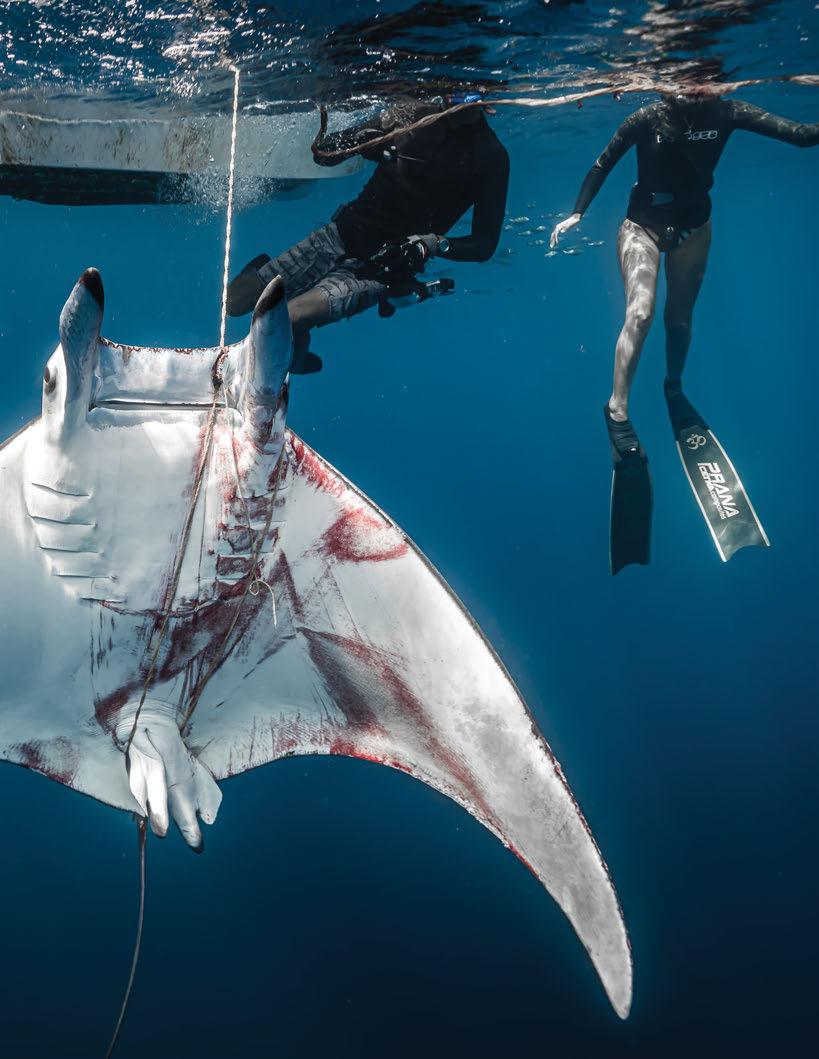 A dead Giant Devil Ray entangled with Fish Aggregating Device lines wrapped around its body.
Photography: John Kowitz
A dead Giant Devil Ray entangled with Fish Aggregating Device lines wrapped around its body.
Photography: John Kowitz
As the sun's warm, golden rays break over the horizon on the Sea of Cortez, they bring Baja to life and ignite one of Earth's most incredible natural spectacles. Within moments a splash breaks the dawn’s silence. It is followed by another, and yet another... until we begin to lose count. As our eyes scan the horizon, we see hundreds if not thousands of Munk’s Devil Rays (Mobula munkiana) launching themselves two metres into the air. The aggregation looks like it extends all the way out to the sun peaking over the horizon in the distance.
We quickly grab our fins and masks then slip into the water. Just below us, thousands of mobula rays soar beneath the waves in what can only be described as a massive, choreographed dance. It is unlike anything else found on Earth. A serene display of thousands of peaceful winged creatures moving together as if they have been practising for this special event their entire lives.
Every year, these Munk’s Devil Rays create gigantic aggregations off the coast of Mexico’s Baja California Peninsula. Their aggregations are the largest of any ray species on Earth. Surprisingly, humans know very little about them or any mobula species, for that matter. However, the little we do know brings a lot of cause for concern.
All mobula species are currently listed on the IUCN Red List of Threatened Species and showing steady decreases in their populations. The IUCN estimates Munk’s Devil Rays have globally undergone a 30–49 percent population decrease in the last 38 years, with a further population decrease expected over the next couple of decades. In some localized mobula populations, these numbers are even worse. A study in Cocos Island, Costa Rica, noted a 78 percent decrease in observational sightings of mobula species in just the 20 years between 1993 and 2013.
In 2020, three incredible female marine scientists joined forces to create the Mobula Conservation Project to better understand and protect mobula ray populations. Co-founders Nerea Lezama Ochoa, Melissa Cronin, and Marta Díaz Palacios are each remarkable in their own right, but by uniting their different areas of expertise and experience under a unified goal that shares a single passion, they bring new hope to the fate of mobula rays around the world.
Melissa explains, “For some populations, we don’t even have the very baseline information on how many there are, so we don’t even know how depleted the populations already are. But what we do know is that we’ve seen global declines, both from fisheries data and from divers.”
“Mobula rays face multiple threats including fisheries, habitat degradation, climate change, and pollution,” Nerea says. “But fisheries are their most important and pressing threat, and therefore, the main focus of most management strategies. We don’t yet have enough
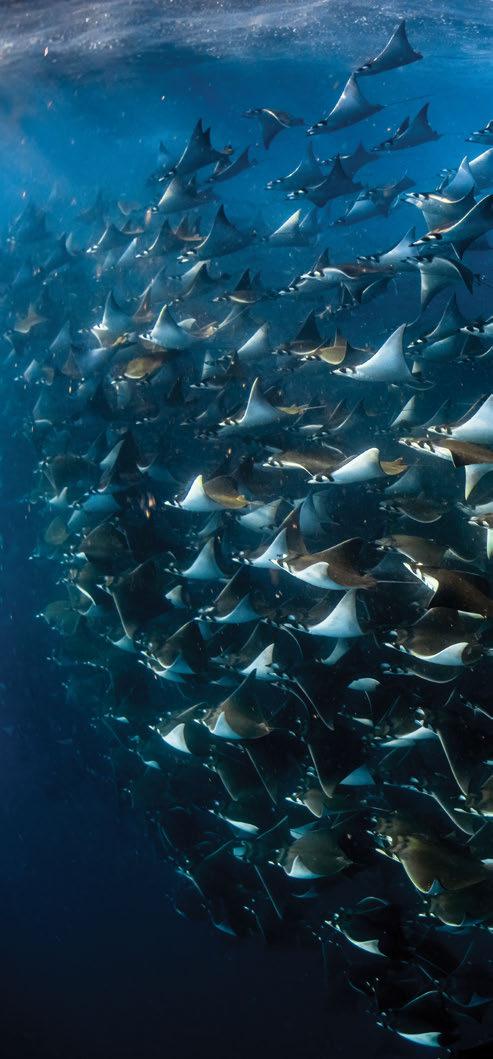

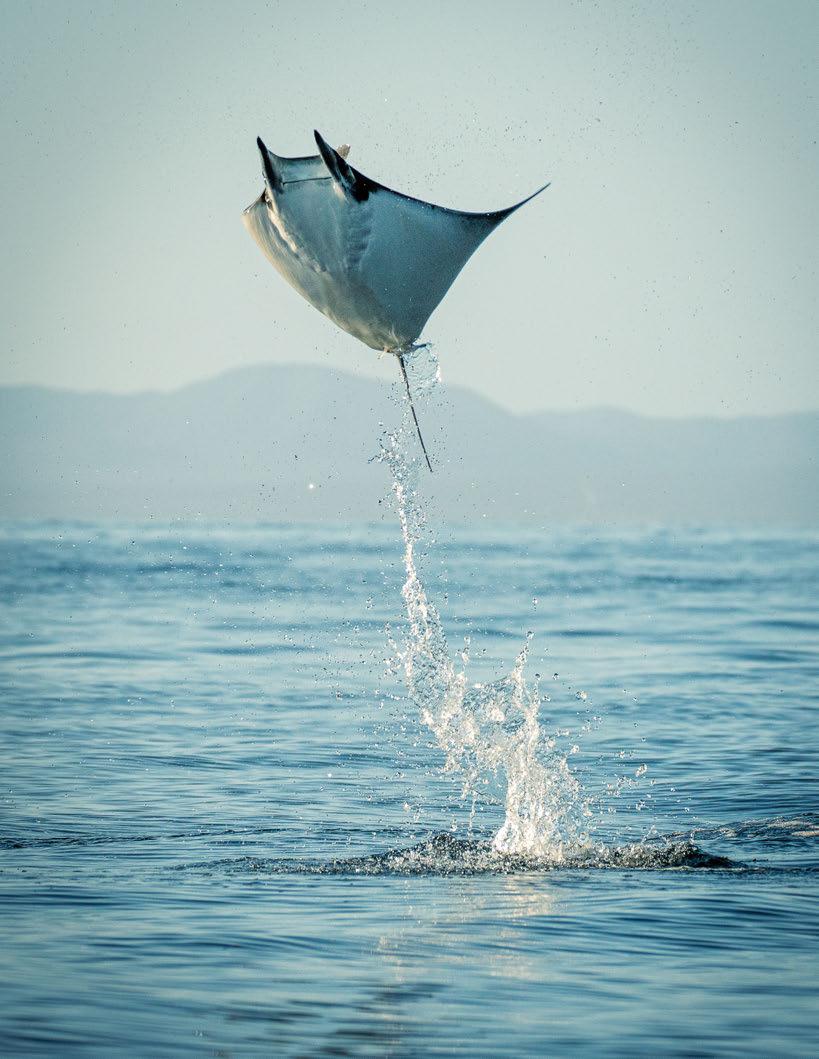
For more information on Dive Ninja Expeditions or their conservation focused mobula ray tours and expeditions visit www.DiveNinjaExpeditions.com or for more ways to get involved or donate to help further Melissa, Nerea, and Marta’s research and conservation efforts please visit www.mobulaconservationproject.com
Munk's Devil Ray can launch themselves up to three meters out of the water. Photography: Jay Clue.information to give an idea of the real and direct impacts that fisheries and habitat degradation could be having on these populations. But what is true, is that if we don’t know the population sizes and trends, we could be depleting their populations even faster than we think.”
Melissa sums up the issue: “Every mobula ray caught and killed in a fishery is potentially a significant blow to the population. They have such incredibly low growth rates and such low capacity to reproduce—these populations can’t stand to lose individuals, much less to lose thousands every year.”
While some mobula species are protected in different countries, such as Mexico, they are still directly targeted both legally and illegally in small scale fisheries around the world. But these numbers pale in comparison to the amount that are caught as bycatch in industrial fisheries. Tropical tuna purse-seine fisheries hold the highest numbers of mobula ray bycatch due to the extensive size of the fisheries. Bycatch is a term used in the fishing industry to label any animal that is unintentionally caught while fishing for a different species. This could be sea turtles, dolphins, birds, mobula rays, or any fish species. It’s sadly something those working in ocean tourism and photography, like myself, have become all too accustomed with. While working with rays, many times we’ll see telltale scars criss-crossed over their bodies. While heartbreaking, I try to find solace in the idea that at least they were lucky enough to get free and continue living. Most aren't that lucky.
Just a few weeks ago, three friends—shark diving guide Alex Schmidt Marquez, underwater photographer John Kowitiz, and marine biologist Lau Velazquez del Valle—set off on the ocean looking to find some of the incredible pelagic animals that have made the waters around Baja so famous. After a few hours without much luck, they decided to stop by a FAD, or Fish Aggregating Device—a humanmade object used by fisheries to attract pelagic fish. The avid freedivers dropped in to see if any fish were hanging around below. But instead, they found a Giant Devil Ray (Mobula mobular) entangled with the lines of the FAD wrapped around its body.
“My first reaction was disbelief,” John says. “I have seen so many graceful mobulas swimming, to see one dead like this was utter astonishment and horror. When we got it on the boat, I thought I saw a twinge of movement. I thought maybe it was my imagination, maybe just hope that it wasn't too late. We quickly lifted it off of the boat and jumped back into the water. The
three of us swam with the ray to see if we could get water moving through its gills and have any chance of reviving it.”
The group worked tirelessly trying to bring the mobula back to life until they realized it was just too late. Alex recounts, “We tried to swim her to pump water and oxygen through the gills without success until the point that we had to let her go and watch as the only ray we saw that day slowly sank into the depths below us.”
Problems like this are one of the many issues the team at Mobula Conservation are trying to combat through research, outreach, and collaboration programs within fisheries and local communities. Whereas it may be easy to quickly point the finger at fishers, it is not the root of the problem. Collaboration with researchers, fishers, NGOs, and other organizations working at sea is what drives future solutions. Many marine scientists wouldn’t be able to gather the amount of data they can or create positive solutions if it weren't for directly collaborating with fishers.
Nerea explains, “In recent years, we have realized that fishers want to be more involved in scientific studies. Collaboration with them is essential to understanding and validating our results, setting priorities for studying one species or another, and identifying future areas that need to be explored. The general lack of information is another problem at the local scale, so if we bring the community to the field or to science, the science will benefit from the community.”
This view of integrated collaboration can also be seen within a newer style of ecotourism projects, such as those created by Dive Ninja Expeditions in Cabo San Lucas that aim to create links between tourism, research, conservation, and local communities. Dive Ninja builds specialized tours and expeditions that not only help fund local research programs but also involve the local communities they work within to help support local businesses and provide alternative incomes while also educating and getting both tourists and locals involved in ongoing research and conservation projects through partnerships with organizations like Mobula Conservation.
Ocean-based tourism generates immense amounts of money globally each year. One study estimates that coral reefs alone generate $36 billion US dollars per year in tourism revenue. If there were a way to tap into even a tiny bit of this resource to further research and conservation efforts it could create far reaching impacts. But it
can also benefit local communities and provide alternative incomes for fishers.
Marta explains: “Tourism can benefit both mobula conservation and local communities when the economical revenue of the ecotourism activities falls to local families—such as ex-fishers, local accommodations, local restaurants, and so on. But it needs to be developed and implemented in a sustainable manner to not cause negative effects on the local environment and targeted species.”
Marta and the team at Mobula Conservation have been developing and implementing responsible tourism guidelines for mobula encounters. But it can be a bit of a race against time when the growing demand for tourism outpaces the government's implementation of regulations, guidelines, and enforcement. Not all tour operators are concerned with the well being of the wildlife they visit but instead have a more shortsighted view focused on reaping quick profits with little regard for the local environment. But Marta, Nerea, and Melissa are working hard to make sure the mobula rays of Baja receive the protection they need.
In the past couple of years, it’s inspiring to see how much these three incredibly talented scientists have accomplished. From assembling the world’s largest collection of mobula tissue for genetic research, to hosting several international workshops with fishers and stakeholders focused on developing new bycatch mitigation strategies or creating Species Distribution Models to identify main areas of importance and their relationship with local fisheries. Female scientists working in what is traditionally a male-dominated fisheries field brings its own set of challenges but also breathes new life into what is possible. As Melissa says, “I also think that women hold a huge strength and a unique perspective when it comes to solving these really complex fisheries issues. We work hard to be role models for other women to show them that women belong, and can succeed, in the fisheries world.”
It is clear that collaboration and partnerships are the way forward to protect mobula rays and our planet's oceans as a whole. Whether it be research organizations teaming up with fisheries, tourism operators partnering with local communities, or just us humans banding together to protect what we love, collaboration is key. By uniting our passions and working together we can create massive positive impacts for all life in our oceans.
 BY LUCERO GONZÁLEZ RUIZ, BIODIVERSITY CAMPAIGNER, GEORGIA STRAIT ALLIANCE
BY LUCERO GONZÁLEZ RUIZ, BIODIVERSITY CAMPAIGNER, GEORGIA STRAIT ALLIANCE
Removal of harmful fish farms from migration routes is critical step to save wild salmon
Wild Pacific salmon are in trouble. Their runs across BC are declining, with record lows in recent years. The Fraser River sockeye salmon run in 2020, for example, was 292,000 fish, compared to a long-term average of 7.2 million. One of the reasons that these stocks are in such distress is because of the many open net-pen fish farms operating in coastal waters on the BC coast.
These farms use large nets suspended in the ocean to grow fish, including non-native species like Atlantic salmon. The nets are the only barrier between the growing farmed fish and the marine ecosystem. Because water flows freely into and out of the farms, so do pathogens, including parasites, viruses like piscine orthoreovirus (PRV), bacteria, and sea lice that can be carried by farmed fish and introduced into the surrounding waters—directly into the paths of migrating wild salmon that must also contend with processing plant waste, also called blood water, that is pumped directly into the ocean.
Several fish farms are already winding down operations following government-to-government consultations between the federal government and Indigenous nations whose territories have housed these unwanted open net-pen farms. All 19 fish farms in the Discovery Islands, as well as many in the Broughton Archipelago, are expected to be removed by June 2022. However, there are another 83 active and licensed marine fish farms in BC.
The federal government has promised the open-net salmon farming industry would be transitioned to land-based, closed containment facilities by 2025.
Over the summer, the Department of Fisheries and Oceans’ stakeholder engagement report, which is part of the process that is guiding the federal government’s transition plan for the salmon aquaculture industry, had some alarming omissions and additions, including:
• No reaffirmation that the nets will be out of the waters by 2025.
• No details on the emerging transition plan.
• The inclusion, as possible alternatives, of other forms of in-water fish farming technologies that do not fully remove the pollution, disease, and waste from wild salmon and the marine environment.
You can show support for removing salmon aquaculture facilities from coastal waters by 2025. By transitioning these farms to closed containment facilities on land, many of the adverse effects from the current interactions between farmed fish and wild salmon will end. Removing open-net salmon farms from the water will help to revive wild salmon and the wild salmon economy and provide new economic opportunities to local communities.
“Salmon are in a state of emergency and decisive action must be taken now to restore and protect their population,” says Christianne Wilhemson, Georgia Strait Alliance’s executive director.
Add your name to the Safe Salmon Declaration (safesalmon. ca/declaration), a petition to:
1. Get the nets out of coastal waters on the BC coast by 2025, or sooner in instances where First Nations do not consent to the presence of open net-pen salmon farms in their territories;
2. Freeze current production levels at farms; and
3. Expand the north coast of BC moratorium for new open netpen farms to all BC coastal waters.
The Safe Salmon Declaration is led by the Safe Salmon coalition, comprised of Georgia Strait Alliance, Living Oceans, and the Watershed Watch Salmon Society.
In BC, 13 out of 17 Chinook salmon populations are threatened or endangered, as are the 74 remaining Southern Resident orcas. Chinook makes up the majority of orcas’ diets as it is their preferred prey, but there is not enough of them—as was evidenced with K-21 (Cappuccino), a 35-year-old Southern Resident male who was extremely emaciated when last seen in July and is presumed dead.

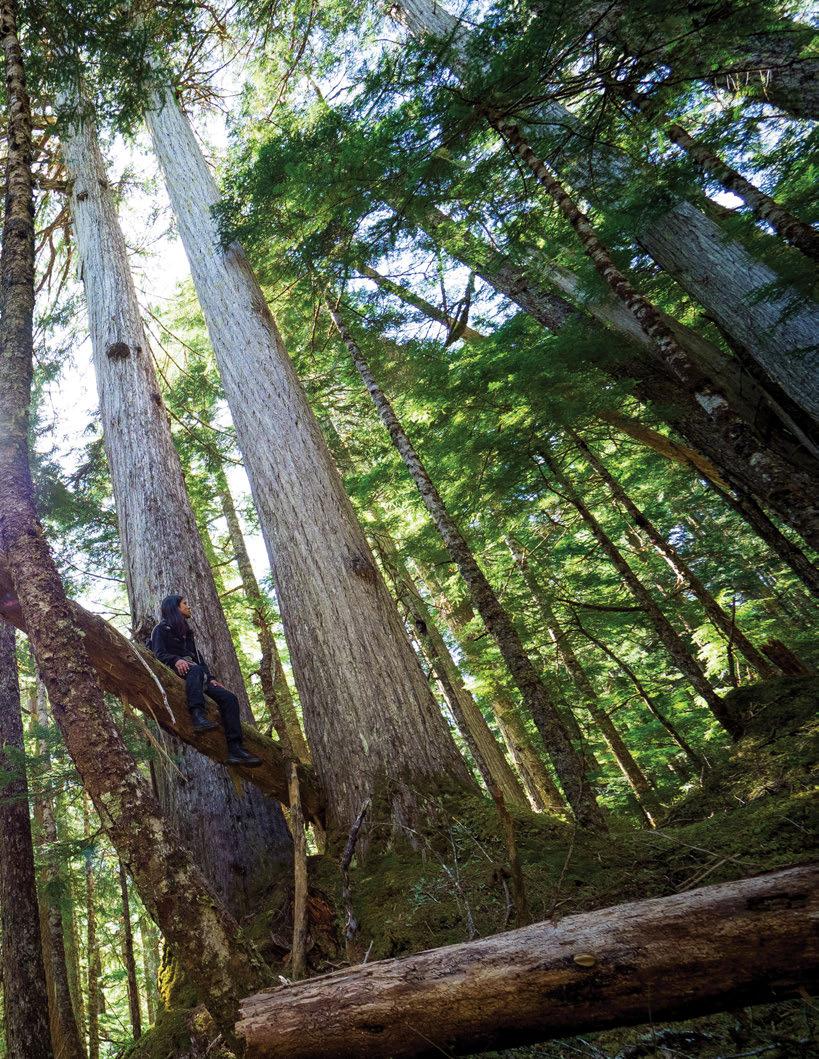

BC’s remaining old-growth forests have been in the national and international news for the past several months as protesters turn out to raise awareness of their plight. These ancient and irreplaceable trees and the ecosystems they support face destruction as government and businesses place their own needs above those of our planet.
Did you know that nine out of ten British Columbians support taking action for endangered old-growth forests? Standing up for the forests can take many forms. If you can’t be in the forests, consider using your skills in different ways. We all have to work together to keep the light shining on these trees. Help us to spread the message far and wide in whatever way speaks to you!
• Every voice counts. Make yours heard! Sierra Club BC has several letter-writing tools to help you send an old-growth message to your MLA, Premier Horgan, and key ministers.
• Send a letter calling on the BC government to protect the last remaining old-growth forests now.
• Did you know that old-growth forests help mitigate climate impacts
like droughts, flooding, and wildfires? Add your voice in asking the BC government to prioritize community safety by protecting and restoring intact forests before the climate crisis worsens.
Hold conversations among your friends and network to find ten more people to send the online letter tool. This could look like a physically distant picnic to discuss old-growth forests, phoning people, or convening an online discussion.
Calling your MLA is one of the most effective ways to get the government to act - even more than petitions. For talking points, check out Sierra Club BC’s old-growth action pages. If you’re nervous to phone in, you can call after hours and leave a message.
Please consider donating to help support work protecting endangered old-growth forests. A monthly gift of just $10 can make a big difference. You can donate to Sierra Club BC via the website.
• Donate funds to Nuchatlaht for legal fees and salmon parks’ traditional salmon laws development.
• Learn about the history of Indigenous Peoples, both before contact with European settlers and since. Reflect on the ongoing violence that Indigenous Peoples face in Canada as a result of the continuing legacy of colonialism and how we can all take responsibility to stop it.
• Learn how to be a peaceful, anti-racist witness in solidarity with the land and water protectors.
• Can you write a letter to the editor or an opinion piece for your local newspaper?
• Are you a member of a sports club or school? Can you write something for your newsletter or e-bulletin?
• Are you a member of a faith community? Can you help your organization dedicate service time to the old-growth cause?
• Are you a carpenter? Advocate for new purchasing policies around the wood your carpentry company orders for building projects. Look for the Forest Stewardship Council (FSC) label to trust that the wood comes from a more sustainably managed forest.
Organize with your friends and family in ways that feel exciting to you. For example, you could:
• Host a community rally outside your local MLA’s office.
• Send your MLA artwork, photos, videos, and stories about what forests mean to you.
• Hang banners in your community and around BC government offices calling for old-growth protection.
• Host a letter-writing or sign painting party.
• Place (without nailing) “Please don’t log me” hearts on trees where you mountain bike, climb, hike, trail run—anywhere you enjoy the outdoors!
• Create a mural with washable chalk paint in front of MLA offices or Ministry of Forests, Lands, Natural Resource Operations and Rural Development office windows saying, “Save old-growth.”
Are you a visual artist, photographer, videographer, poet, writer, or creatively-minded in another way? Please share your work as widely as possible with messages about why these ancient trees are important to you. Whether sharing on social media or in a gallery or publishing your work in a local magazine or a personal blog, it’s all raising awareness.
• Learn how to document concerning logging and engage with companies and local governments with Sierra Club BC’s helpful guide.
• Register plant and animal species sightings in old-growth cutblocks
flagged for logging by corporations or BC Timber Sales. You can register these sightings in the BC Conservation Data Center.
• Phone licensees operating in your area and ask for meetings to increase the social pressure on the company.
Share a photo, video, piece of art or written piece about why forests matter to you. Tag government officials to call on them to #SaveOldGrowth. (Pssst… be sure to tag @sierraclubbc and @savingearthmag so we can give your post a boost on our channels).
• Download Sierra Club BC’s Old-Growth Forest Fact Sheet and find all our latest forest data, maps, press releases, blog posts, and media on the Forest Stories page.
• Watch Sierra Club BC’s webinar with Finding the Mother Tree author and UBC professor Suzanne Simard. We chat about Suzanne’s scientific quest to discover the tree elders that nurture forests in ways that remind us of human families—by caring for each other, sharing food, and sheltering their young.
• Read Sierra Club BC’s report on reducing community climate risks through forest protection and a paradigm shift in forest management.
• Read the independent scientists’ report detailing just how few big, old trees remain in the province.
• Read about how ending clear-cutting in BC is as important for the climate as phasing out fossil fuels. Check out Sierra Club BC’s Clearcut Carbon report.
• View and download the map State of Vancouver Island’s Coastal Temperate Rainforest showing the scarce endangered old-growth rainforest ecosystems and recent old-growth destruction on Vancouver Island.
• Read Sierra Club BC’s submission to the provincial government’s oldgrowth review panel.
Explore Sierra Club BC’s free educational resources for kids from kindergarten to grade 8 to help them learn all about the wonderful forests in BC.
Think about how you are breathing with a tree. It needs the carbon dioxide you breathe out, and you breathe in the oxygen that it releases. We are all connected.
Protecting these forests can be exhausting and heartbreaking work, and while it may be daunting, the prospect of life without forests is even more horrifying so we have to ask everyone now to give a little time to bring attention to this situation.
If you have any questions or would like support in taking these actions, please contact Sierra Club BC’s lead organizer Flossie Baker at flossie@sierraclub.bc.ca.
This article was edited for print and was originally published on the Sierra Club BC website (sierraclub.bc.ca/30-ways-to-stand-up-for-old-growthforests). You can find links to all the templates and documents quoted there.

Greenpeace activists in front of the Austrian parliament protesting and demanding a national ban of the cancerous weedkiller glyphosate.

MITJA KOBAL / GREENPEACEBY DINA NI
It's time to finally phase out glyphosate and all the nefarious pesticides from our forests.
Spraying forests with glyphosate herbicide, also known as “the rain of death,” is a long-overdue environmental issue to be resolved. The goal of aerial spraying is to suppress all tree species except for the ones that are useful for commercial purposes.
Obviously, Greenpeace cannot be silent in the face of such an atrocity. So, we have launched a public petition to finally stop the practice. However, it is essential to answer a few questions first to grasp what is actually happening.
Every summer, the newly growing forests of Ontario are getting sprayed with an herbicide called glyphosate. And these forests are real fighters. First, many of them are clear-cut by the logging industry, which is just the beginning of their struggles. Once they start recovering, they are given a toxic spray so that only the profitable species get to survive.
However, it is not the same for the whole country. Although glyphosate spraying is permitted in nine out of ten provinces, Quebec banned all herbicides for forestry back in 2001. So, the precedent has been set. Following this lead, last year a number of protesters in Nova Scotia managed to stop the practice of glyphosate spraying onto their local forests. Thousands of people in New Brunswick and British Columbia are opposing this practice in their provinces, as well. And in Ontario, many First Nations have been making their opposition to “the rain of death” very clear. In other words, banning herbicide from contaminating our forests is not impossible but within reach thanks to people power across the country.
Glyphosate is the main ingredient in Monsanto’s Roundup, the weedkilling pesticide. The idea behind its usage is to turn once-healthy natural forests home to countless plants, animals, and insects—into near monocultural landscapes of pine and spruce tree stands that are valuable for logging.
Although glyphosate clearly does more harm than good, it is still the most popular herbicide on the planet. It is cheap and efficient, so it is obviously beneficial to big companies—at the cost of our wildlife and nature. Therefore, we are dealing here with supervised and scheduled contamination of our forests, which has been practised for decades now.
So, the impacts of this atrocious aerial spraying are far-reaching. First of all, we end up with a handful of trees beneficial for logging but definitely not for the ecosystem’s integrity. Also, according to Dr. Lisa Wood at the University of Northern British Columbia, the residues of glyphosate are absorbed by plants that are food sources for a variety of wildlife, and they remain with us for years to come.
But that’s not all. The technique of aerial spraying with glyphosate is also exacerbating the effects of climate change that we are already facing today. In her interview with the CBC, Lori Daniels, a forest ecologist at the University of British Columbia, describes how monocultural forests are much drier, which makes them more vulnerable to forest fires. Besides, an additional fire trigger is probably the last thing we need at the moment.

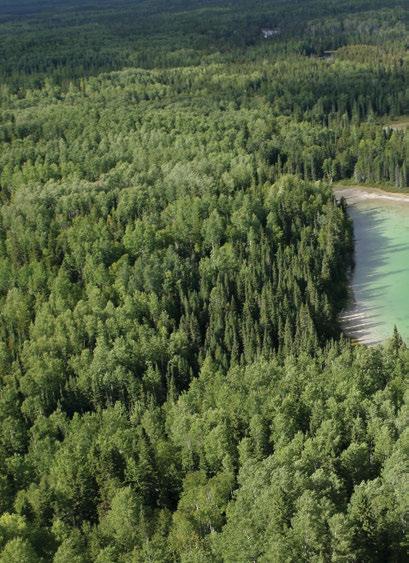


According to estimates provided by Climate Atlas of Canada, the number of fires on dry and windy days will increase by 50 percent in Western Canada and by 300 percent in Eastern Canada by the end of the century. Living in this new era of heatwaves, it is simply unwise for us to turn our forests into tinder boxes by prioritizing trees that are prone to wildfires.
As for the impacts of glyphosate exposure on human health, there is a growing amount of scientific evidence proving its various negative effects. For example, the article "Exposure to glyphosate-based herbicides and risk for non-Hodgkin lymphoma: A meta-analysis and supporting evidence" by Luoping et al. demonstrates that it can lead to the development of certain types of cancer. Professors Juan Muñoza, Tammy Bleak, and Gloria Calaf, in their joint work "Glyphosate and the key characteristics of an endocrine disruptor: A review", describe how glyphosate exposure can trigger a variety of fertility and reproduction-related issues in both men and women.
Many Indigenous nations directly depend on the integrity of the lands, waters, and wildlife in their traditional territories. That is one reason the Traditional Ecological Knowledge Elders of the North Shore of Lake Huron reacted to the situation by pointing out the following: “The aerial spraying of glyphosate violates our Treaty rights to the water and to hunt, fish, and gather berries and plant medicines in our traditional territories. Treaty rights are recognized and affirmed in section 35(1) of The Constitution Act, 1982. We are the caretakers of the lands and waters that were given to us by the Creator so that we may continue to live as Anishinabek people for generations to come.”
To put it simply, spraying the forests without Indigenous People’s consent repeatedly violates their basic human rights to health and livelihood. It interferes with long-lasting relationships between First Nations and their territories. Although many have been calling out the practice for years now, the government still does not pay enough attention and continues to prioritize the commercial interests of a few logging companies over the health of the people.
Greenpeace believes in environmental rights for all. So, we have recently launched a petition to make Doug Ford stop the glyphosate spraying in Ontario. Together with the public and our supporters we can put an end to the use of harmful herbicides in forests across Canada.
It’s time for all provinces to follow Quebec’s example. The practice of spraying forests with toxic substances can and should be prohibited. We need to learn how to live in harmony with nature because it needs us just as much as we need it. And we don’t mean for industry profits—our survival is at stake.
Together, we can call out our authorities to finally phase out glyphosate and all the nefarious pesticides from our forests. If we manage to end this toxic practice in Ontario, we can help to keep the ball rolling across the country and finally secure ourselves a toxinfree environment.
A good start would be signing this petition: https://act.gp/3e9loQu.
 by Sergio Izquierdo
by Sergio Izquierdo

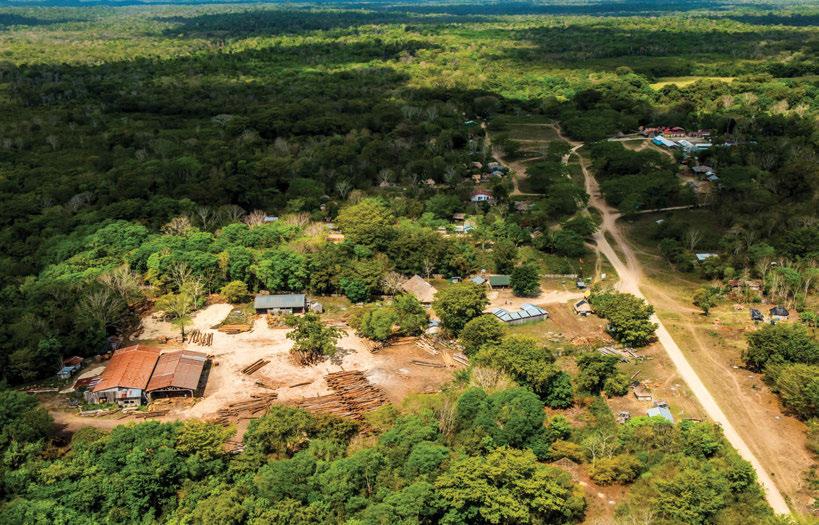
 Airstrip and abandoned plane used by drug traffickers in Laguna del Tigre. Photography: Sergio Izquierdo.
Uaxatún community and its wood management facility. Photography: Sergio Izquierdo.
Airstrip and abandoned plane used by drug traffickers in Laguna del Tigre. Photography: Sergio Izquierdo.
Uaxatún community and its wood management facility. Photography: Sergio Izquierdo.
It is hardly breaking news that our planet finds itself in the middle of a climate crisis and that deforestation is one of the main causes. In 2020, our world lost a forest area larger than the size of the United Kingdom, including more than 4.2 million hectares of primary tropical forest (according to data published by the University of Maryland). Thousands of hectares of forests have disappeared in the Amazon due to the continual push for more land development by large-scale agriculturalists and cattle ranchers. Canada, so often praised as an environmentally aware country, maintains its own damaging forest management model, allowing clear-cutting, old-growth logging, and monoculture forests.
Earth still has approximately 1,110 million hectares of primary forest left, which need to be protected. We must also work to recover what has been lost. In Guatemala, we find a uniquely inclusive and innovative forest management model, which considers the needs of people and the ecosystem. This model centers on community forestry concessions that manage 500,000 hectares of land in the Maya Biosphere Reserve (MBR).
I have been observing and documenting Guatemala’s forest management model for many years. In 2012, I arrived in Carmelita, a small village that sits at the edge of the jungle. This community organized my five-day jungle trip to El Mirador, an archeologically important Maya city in the middle of MBR in Petén, Guatemala. When I arrived in Carmelita, I was shocked to see trucks transporting massive logs from the area. An American archaeologist who works at El Mirador, Richard Hansen, also showed me photos of trucks transporting logs from the Uaxactun community (also in MBR). His goal was to stop this kind of logging, and I offered him my full support. At this point, I was not yet aware of the community forestry concessions, which would completely transform my thinking.
Guatemala has lost more than half of its forest area since the 1980s. Guatemala’s southern forests have been totally destroyed, mostly by destructive monocultures such as "certified" palm oil crops (plantation certifications are often corrupt). Guatemala’s northwestern forests have also been destroyed by drug trafficking, despite being within the Laguna del Tigre national nature reserve. Drug traffickers destroy forests to build airstrips and cattle ranches for laundering money.
In 2015, I was hired to photograph a cattle ranch near Laguna del Tigre, although I did not immediately realize the heavily armed ranchers running it were drug traffickers. These ranchers said that presidential candidates would contact their “boss” to receive financial help and helicopter access so they could move easily across the country to campaign. I found two airstrips on the ranch, and the main road was made from stone taken from a Mayan temple that they destroyed. Those who elect corrupt politicians in the region as well as North Americans who fuel the demand for recreational drugs are complicit in this system.
Conserving in this area of Guatemala purely from state funds appears impossible. It is very easy to talk about conservation with a full stomach, but the communities living in this area have been poor for a long time. Their only income comes from drug traffickers who give them money to burn the jungle and build airstrips. To maintain this
income, they defend the drug traffickers’ illegal activities with whatever it takes. This is known as trafficking with poverty.
CONAP (the National Council of Protected Areas in Guatemala) also has very few park rangers (449 rangers to manage 3,471,366.01 hectares; that is, 7,731 hectares per ranger) and very little interinstitutional support. They have a budget that is below half of what is necessary.
The only area that remains relatively stable is the northeast, where the MBR is located. The MBR jungle is located in the Petén Department, the largest region in Guatemala, which borders on Mexico and Belize. The MBR contains community forestry concessions, which protect natural parks, such as El Mirador, Tikal, and Yaxhá. Over a number of years, I had several assignments documenting Petén. These assignments explored its incredible natural beauty as well as its problems and major threats. I came to understand the game of chess that is the struggle for control in Petén with the ultimate trophy being control of the Maya Biosphere Reserve.
The community forestry concessions were created as part of the Guatemalan Peace Accords, signed in 1996, ending 36 years of civil war in Guatemala. These accords guaranteed that Indigenous Peoples and rural people would be given at least 100,000 hectares of land. This became the foundation for community forestry concessions, which have had a positive impact on the environment, economy, politics, and cultures of local communities as well as helped protect the forests and our environment.
Currently, there are 19 community concessions (these include Cooperativa Carmelita, OMYC [Uaxactún], and Sociedad Civil Suchiteco, among others). Together, these form the Association of Forest Communities of Petén (ACOFOP), which was established one year after the accords were signed. Since its inception, ACOFOP has received many national and international awards, and has been internationally recognized as a management model for other countries. ACOFOP boasts a near-zero deforestation rate and helps local communities provide for themselves. They also protect biodiversity (ending illegal logging and preventing forest fires) and cultural heritage, and provide economic opportunities. Forests, through the work of ACOFOP, are reintegrated as primary natural assets of local communities. ACOFOP is certified internationally by the Forest Stewardship Council and guarantees sustainability in all of its activities.
These community forestry concessions grant permission to extract certain types of trees with a prescribed minimum width and height up to a maximum volume of wood per harvest. Assigned areas are divided up to be harvested on a rotational basis. Each year within one area, around one tree per acre is cut down, and then this area is not touched again for 40 years. In this way, trees beneath those that are felled can grow to a specified height and width, so they will only be cut down in the next cycle. This model is entirely different from the North American clear-cutting model, which is a major contributor to carbon emissions and the loss of carbon capture opportunities.
These community forestry concessions also provide income from highly nutritious ramón tree seeds and xate (palm leaves exported to the US and Europe for floral design). These income sources have minimal impact on the forest, unlike other sources, such as mega tourism projects or uncontrolled logging. They also allow communities to live in a more dignified way, providing for their families through legal means rather than through illegal means, such as poaching.
Petén can be divided into two parts, the north and the south. The south part has been totally destroyed, mostly by destructive monocultures such as "certified" palm oil crops.
Photography: Sergio Izquierdo.

With these sources of income and taxes from the forestry concessions, communities are able to fight against illegal loggers and cartels without relying on the state. Forestry concession communities take care of the forest by patrolling it, preventing fires, and fighting against illegal logging.
Although these concessions primarily benefit local communities, they also contribute to effective action against global climate change. Their work is recognized internationally as a sustainable model that could be replicated throughout Guatemala. We believe this model could extend to other global Indigenous Peoples living in endangered forests.
In Guatemala, NGOs, companies, and individuals manipulate information to benefit their interests. Economics is valued more than protecting forests and other environments. The American archeologist in El Mirador, Richard Hansen, and the NGOs he partners with are guilty of this kind of manipulation. To dissolve the concessions so he can increase his work area, Hansen is trying to have El Mirador declared a basin, which would then be reclassified as a “biotopo” reserve. He is involved in a strong marketing campaign to promote the area as a basin; however, scientific studies by Guatemalan universities and other entities using LiDAR technology show that the region is actually a plateau.
Hansen's harmful plan is far-reaching. He hopes to get a bill (S.3131, named the Maya Security and Conservation Partnership program) passed in US Congress that will force various Guatemalan communities to stop logging, which would remove their main income source. This bill falsely implies that the basin needs to be protected and gives power to an American non-profit organization and its partners to step in an manage the land, creating an area in Guatemala ruled by American interests. With this bill, the US would “give” a lot of money to the Guatemalan government, which would actually need to be paid back. This would lead to huge debt and the government would also need to absorb the costs of protecting forests that would no longer be under the
protection of community concessions. Without concessions in place, plans for big infrastructure projects, like the construction of a train and a mega “eco” hotel complex, will lead to even bigger tourism projects and greater destruction of the jungle.
Although bill S.3131 was introduced in 2019, Hansen has been trying to “land grab” in Guatemala since 2002. He almost succeeded through a Guatemalan presidential decree to establish the Mirador Basin Special Archaeological Zone, which removed concessions in the area despite it having 25-year government contracts. Protests led to social discord and economic uncertainly, and by 2005 the decree was declared unconstitutional and rescinded. The community forestry concessions were reinstated.
Today, the MBR is facing even bigger threats. Several wealthy and powerful business people from large mining, sugarcane, and palm oil companies in Guatemala are pushing for an “urgent” law initiative called “The Rescue of the pre-Hispanic Heritage.” This law (no. 5923) will privatize every pre-Hispanic site, so that infrastructure can be built. This will harm biodiversity and local communities in exchange for huge economic gains. This law was presented on June 10, 2021, and the Indigenous People Commission, chaired by Deputy Petrona Mejía, has already asked to revoke it, calling it out as racist.
Protecting global forests is necessary for combatting climate change and ensuring the survival of all species and ecosystems. Preventing further colonization of Indigenous communities must also be prioritized and financial exploitation deterred. ACOFOP’s community forestry concessions model has succeeded in this for several decades. It could also be replicated in other countries such as Canada and Brazil (which together with Russia host 61 percent of the world’s remaining forests). Learn more about community forestry concessions by visiting https://acofop.org/en/
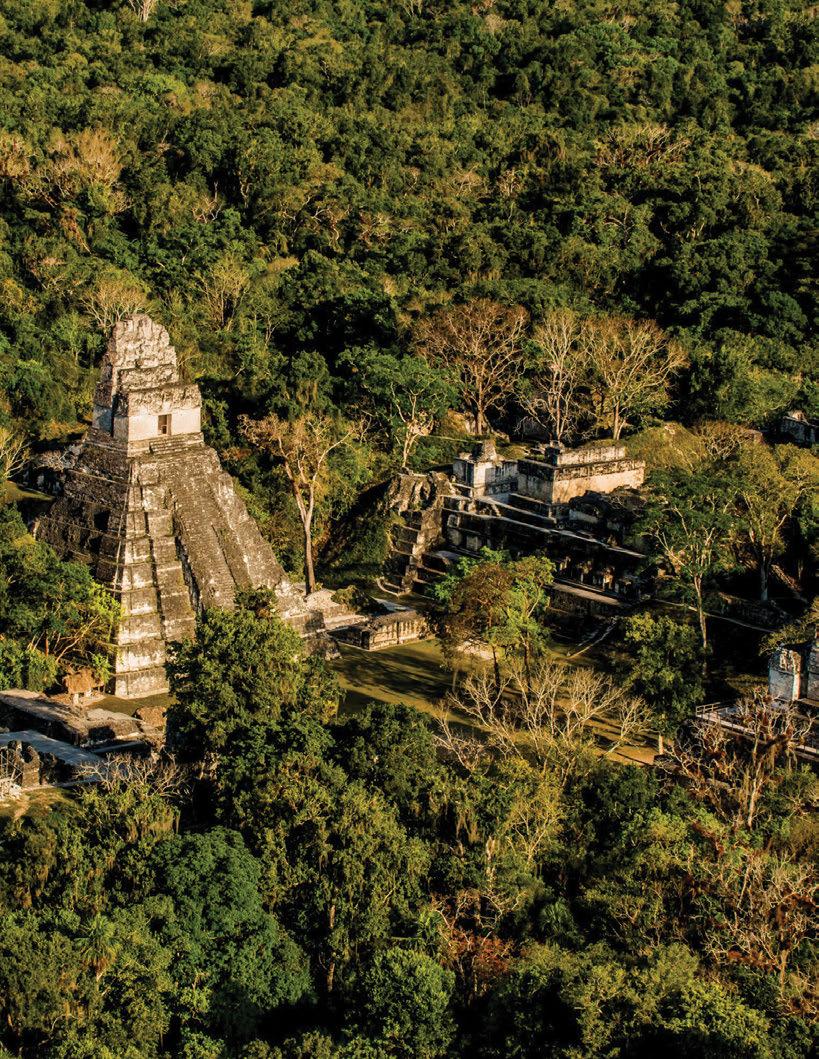
• Anonymous Hero: Awarded by the System of United Nations in Guatemala
• National Geographic: Recognition for conservation leadership in Latin America
• CGIAR Prize for “Project from The Market of Innovations”: Recognition from 16 global centres of scientific research into agriculture livestock, and fishing
• ACICAFOC Indigenous and Peasant Agrobiodiversity Program in Central America: Recognition for contribution to community agroforestry and the management of natural resources in Central America
• UNDP Equator Initiative Certificate of Excellence: Recognition for biodiversity conservation and poverty reduction (presented at the World Summit on Sustainable Development in Johannesburg, South Africa in 2002)
• National Forest Prize: Recognition from the National Forests Institute of Guatemala for achievements in Guatemalan forest development (2002)
• The United States Embassy (through USAID): Recognition for the efforts made in the fight against forest fires (2003)
• Environmental Torch Prize: Recognition from the International Union for the Conservation of Nature (IUCN) for Latin American leadership in environmental issues (2006)
• The Environmental Presidential Medal: Recognition from the government of Guatemala for achievements in conserving the Multiple-use Zone of the Maya Biosphere Reserve (2003)
• Sustainable Standard-Setter Prize: Recognition from Rainforest Alliance for protecting biodiversity through the participation of community organizations (2007)
• The Guatemalan Ministry of Agriculture, Livestock and Food: Recognition from the Vice Ministry of Petén Affairs, for ACOFOP’s work for its invaluable dedication, commitment, effort, and close collaboration in the development of the Petén department (2015)
• The Forest Stewardship Council (FSC) and the National Council of Standards of Sustainable Forest Management for Guatemala (CONESFORGUA): Recognition for employing the International Forest Certification in conserving Maya Biosphere Reserve forests (2016)
• Mexican Network of Farmer Forestry Organizations: Recognition for successes in the forestry development of Guatemala (2017)
• Over 20 International Awards for Macedonio Cortaye, Leader of the Concession Project
• Recognition for Macedonio Cortaye’s leadership, including an honorary doctorate from the University of San Carlos of Guatemala for promoting the integral management model of natural resources and the conservation of the Maya Biosphere Reserve
• Landscape Award, Second Place: Recognition from the Global Landscapes Forum (Bonn, 2018)
• Government of Guatemala: Recognition For ACOFOP’s “Petén Community Forest Model” (presented on the 30th Anniversary of the Maya Biosphere Reserve, 2019)

WHILE THE RESISTANCE TO PIPELINES RAMPS UP IN NORTH AMERICA, IT IS TIME TO HONOUR INDIGENOUS LIFE OVER FOSSIL FUELS.
Mne Sota Makoce—The air is thick with the heat and energy of Water Protectors gathering. Voices echo out across the road that is blocked off by cars to protect the Water Protectors on Anishinaabe land as thousands of people gather alongside Leech Lake and Fond du Lac Nations. The fight against Enbridge’s Line 3 hits a peak, one in a long line of building momentum.
This was the scene I saw in June as I joined the Treaty People Gathering, an event organized to stand up against Enbridge’s Line 3. This event was intended to gather in Northern Minnesota to put our bodies on the line, to stop construction, and to tell the world that the days of tar sands pipelines are over. It was organized by non-profit organizations wanting to support the Ojibwe bands that would be affected by the construction in what is now called Minnesota state.
While I joined the Treaty People Gathering at Coffee Pot Landing, there were also hundreds of activists who went to a blockade of the Line 3 Pump Station just miles away. I remember the scattered shouts across Coffee Pot Landing as news of the arrests at the Pump Station spread through the rally. The Gathering was just the latest in a long history of Indigenous voices and their allies standing up against these kinds of developments. The whole experience reminded me of my time at home, in Standing Rock, three years ago. It reminded me of the voice of my elders from the Toh Nizhoni Ani sharing teachings about the Black Mesa fight against coal. All of these fights are connected.
Yá'át'ééh, my name is Brenna TwoBears. I am Bitterwater born for Warrior clan. My maternal grandfather is Red Running Through Water, and my paternal grandfather is Standing Rock. In these ways, I am a Diné, Ho-Chunk, and Standing Rock person from Flagstaff, Arizona, and Black River Falls, Wisconsin.
Where I grew up, resource extraction has always been prioritized over the people. My mother taught me that. She said that the uranium and coal extraction on the Navajo reservation put our elders in the hospital, and she said it all started when they stole the land from our ancestors.
Whether it’s the Dakota Access Pipeline or the general cessation of land throughout Wisconsin, a horrifying number of Indigenous people suffer from the greed of capitalism. Even if we narrowed down our scope from more than 500 federally recognized tribes in the United States, it wouldn’t begin to cover the damage and degradation wrought over the past four centuries. There isn’t one Indigenous person who hasn’t grown up with respect for the land and seen that respect thrown right back in their faces every day in a world that doesn’t respect their culture or the Earth.
It is what I see every day. It is what I saw in Mne Sota Koce.
Protest against the Line 3 pipeline, St. Paul, Minnesota. Photography: Fibonacci Blue.
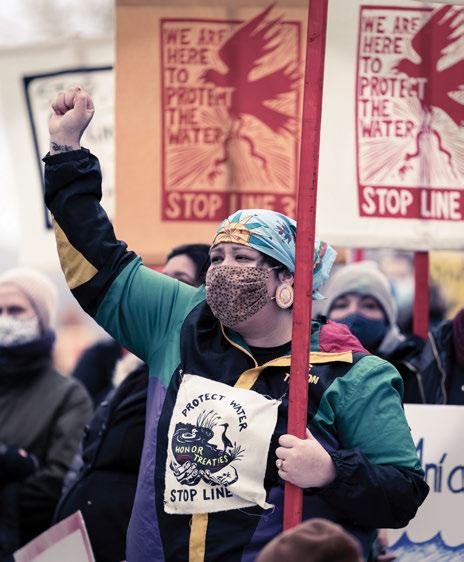
In 1961, the existing Line 3 was built to ship crude oil from Alberta to Superior, Wisconsin. It spanned northern Minnesota in Leech Lake and Fond du Lac reservations, otherwise known as 1854, 1855, and 1842 treaty land, and it was built with faulty steel. Throughout the years, it experienced ruptures and spills, including a one million gallon spill in 2010 on the Kalamazoo River.
As the biggest Enbridge project to date, here’s the issue with Line 3: Enbridge is all set and ready to abandon its trash (the existing Line 3 pipeline) on treaty land and begin a new pipeline through Anishinaabe territory.
According to this violation tracker (violationtracker. goodjobsfirst.org/parent/enbridge), Enbridge already owes upwards of $2 million in penalties over the past two decades. The State of Minnesota calculated the “social cost of carbon” as almost $300 billion over the first three decades of the new pipeline’s existence. Historic and sacred sites under protection of the National Historic Preservation Act are sliced and diced and put up for the highest bidder, wild rice beds are at risk and the potential for spills rides high due to this worst possible route for the proposed pipeline.
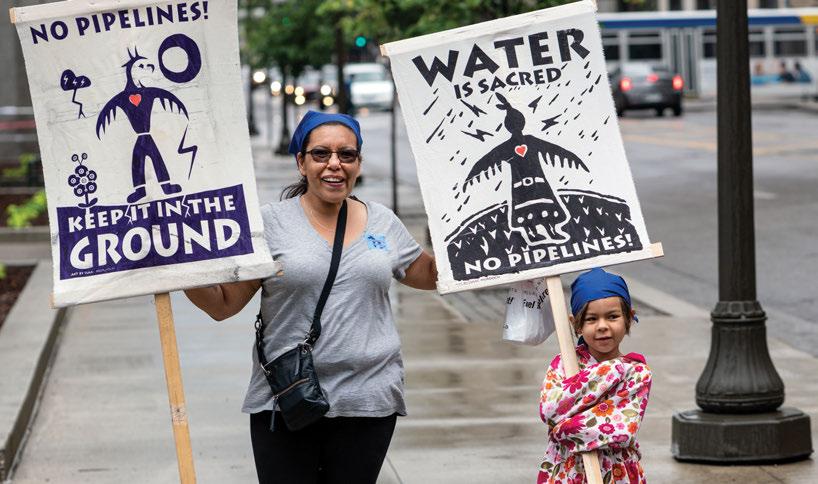 LEFT: A protestor at Protect the Water, Revoke the Permits! Rally in St. Paul, Minnesota. BELOW: A grandmother with her granddaughter holding signs against Enbridge's proposed Line 3 pipeline outside the MN Public Utilities Commission hearing on Line 3 in downtown St Paul Minnesota. Photography: Lorie Shaull.
LEFT: A protestor at Protect the Water, Revoke the Permits! Rally in St. Paul, Minnesota. BELOW: A grandmother with her granddaughter holding signs against Enbridge's proposed Line 3 pipeline outside the MN Public Utilities Commission hearing on Line 3 in downtown St Paul Minnesota. Photography: Lorie Shaull.
Moreover, we have an excess of fossil fuels already in production worldwide to support a full wind down of coal, oil, and gas plants to stay within a 1.5 degrees C pathway if we stopped extracting fossil fuels this second.
Most recently, the Line 3 Water Protectors succeeded in gaining a court issued restraining order against Hubbard County & Sheriff to end the police blockade of the Line 3 camp. The order was co-issued by Center for Protest Law and Litigation, co-counseled with EarthRights’, Jason Steck, and Indigenous lawyers Tara Houska and Winona LaDuke.
This fight is a reflection of the ongoing struggle of Indigenous people across North America for a long time, but there is a precedence of success with the sacred right of Indigenous people. We can see that in the wake of the huge win in the fight to shut down the Dakota Access Pipeline, the resilience of Indigenous people in enforcing their rights can only be good for the people and the land. However, cases like the Navajo nation’s empowered transition away from coal and their establishment of the Navajo Transitional Energy Company (to continue coal mining in Wyoming, which makes them America's third biggest coal producer), show that we still have more work to do.
The Fossil Fuel Non-Proliferation Treaty Campaign aims to foster a global equitable transition away from fossil fuels to clean, low-carbon energy and economies. It can cover the huge blind spots on fossil fuel production in existing international agreements on climate change and build a new model for reciprocal relationships with Indigenous Peoples across the world.
The Treaty operates under three pillars. The first seeks the non-proliferation of coal, oil, and gas by ending all expansion and new project plans. The second addresses the phase out of the existing stockpiles and production. The third prioritizes a commitment to fast-tracking real solutions and a just transition for every worker, community, and country.
I remember the first time I saw the Treaty’s website. I was in awe at how well a non-tribally affiliated mission could cover so many bases. What stood out to me most, and what continues to play a part in our work, was the final pillar: equity in a fossil fuel phase out. Equality and justice lay the groundwork in what some might call the most foundational pillar in the Treaty campaign, and that is non-negotiable when it comes to Indigenous Peoples.
In thinking about what type of world we would need to ensure a just transition, I turn to my ancestors’ teachings passed down through generations before me. The Treaty’s North American partner, the Indigenous Environmental Network, lays these out in three Indigenous Principles of Just Transition to rebuild our nations and communities.
• Responsibility and Relationship: The recognition of Indigenous connections and lifeways as valuable within a new global system that prioritizes balance and harmony with all.
• Sovereignty: The inherent right of Indigenous Peoples to steward the land, and the authority of Indigenous-based agriculture and bio-cultural diversity.
• Transformation for Action: Restructuring the roles for underrepresented groups, as well as the standards of living for communities around the world.
I see these values reflected in what the Fossil Fuel Non-Proliferation Treaty promises. If applied to the fight at Line 3, all the issues laid out by

frontline organizers would be addressed. Indigenous knowledge would be taken seriously, like it should have been from the very beginning. The governments would bear the brunt of the cost to switch to renewable energy, and nothing like this would ever happen again. This could become a chance to right the wrongs that colonization has wrought on Indigenous Peoples. Now is the time to act.
Unlike four centuries ago, the political landscape is different now. This includes the confirmation of Deb Haaland as the 54th Secretary of the Interior, which makes her the first Indigenous lead of a Cabinet agency to care for the land and natural resources. Awareness of generational trauma is rising and the rights of Indigenous Peoples officially recognized within the United Nations. Indigenous Peoples are taking huge steps everywhere around the world.
Though these fights for land and future generations started with stolen resources, they will not end that way. The Fossil Fuel Non-Proliferation Treaty is a completely different animal going by a similar name; this agreement is not meant to trick or steal, but to empower and spread the wealth. It takes into account the workers who depend on energy for their income, the cost to come with such a shift, and the truth that wealthy countries deserve to shoulder that burden. Most importantly, it holds Indigenous dreams as the ultimate goal to which to aspire and the rules by which to act.
It was my honour to join the actions at Line 3 on behalf of the Fossil Fuel Non-Proliferation Treaty Initiative, as an Indigenous person and as a believer. It is also my honor to work with them and to bring a step to communities around the world that finally offer a solution I can stand behind.
To get involved in the campaign for a Treaty, see our Campaign Hub. Here, you can learn how to endorse the Treaty, share information about the Treaty on social media, and call on your city to endorse it. If you have any questions about the campaign or our upcoming events, please visit our website at fossilfueltreaty.org or get into contact with our communications team media@fossilfueltreaty.org.

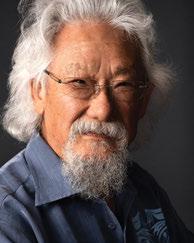 David Suzuki, Photography: Jennifer Roessler
David Suzuki, Photography: Jennifer Roessler
There’s little in the Intergovernmental Panel on Climate Change's (IPCC) latest report that we didn’t already know. It’s shocking nonetheless—albeit with a glimmer of hope.
The first of the four-part Sixth Assessment, “Climate Change 2021: the Physical Science Basis,” confirms that human activity—mainly burning fossil fuels and destroying natural carbon sinks—is heating the planet at unprecedented and accelerating rates, that warming will continue at least until mid-century no matter what because of emissions already emitted, and that global warming will exceed 1.5 or 2 degrees C this century unless we rapidly reduce emissions.
The report also details the disastrous consequences of not acting, from increasing extreme weather to impacts on water cycles and agriculture.
“Many changes due to past and future greenhouse gas emissions are irreversible for centuries to millennia, especially changes in the ocean, ice sheets, and global sea level,” it states.
A leaked draft from the third working group goes further, stating that “emissions must peak in the next four years, coal and gas-fired power plants must close in the next decade, and lifestyle and behavioural changes will be needed to avoid climate breakdown.” (The assessment includes three parts and a synthesis report, each subject to approval by 195 member governments.)
Every assessment since the first in 1990 has warned that we face an uncertain future if we don’t address climate disruption. Research methodologies have improved, evidence has mounted, and it certainty has become absolute since then, but we knew where we were headed. This report confirms we’re already there.
We can see it ourselves: unprecedented heat waves, wildfires, flooding, droughts, species extinction, water scarcity, conflict… The almost-4,000page report’s evidence—compiled by 284 expert authors from 66 countries who reviewed 14,000 studies representing the most up-to-date climate science—is incontrovertible.
UN Secretary-General Antonio Guterres called it a “code red for humanity” that “must sound a death knell for coal and fossil fuels, before they destroy our planet.”
There’s no denying that we need to act fast or face accelerating climate chaos. The reasons go beyond attempting to stabilize the climate: rapidly reduced pollution and related health care costs, better employment and economic opportunities, fewer impacts on land and water, and numerous co-benefits.
But I ask again (I’ve been banging on about this for as long as the IPCC has been releasing reports), why the hell aren’t we doing more? Why, after more than 30 years of mounting evidence and certainty (almost 200 since the greenhouse effect was first observed), as well as easily observable evidence, are media outlets of record still publishing anti-science nonsense by industry shills and deniers? Why are governments failing to do what’s necessary?
The IPCC report indicates we can’t and needn’t give up hope. But averting the worst impacts of the crisis means rapidly shifting away from fossil fuels, protecting natural carbon sinks, and employing “negative emissions technologies” and nature-based solutions to remove CO2 from the atmosphere.
Governments that talk about climate commitments while buying pipelines and subsidizing fracking—or worse, whine that transitioning from fossil fuels is “unrealistic” and “utopian”—aren’t helping. Nor are media outlets that either downplay the climate crisis (often through lack of coverage) or spread false information in service to the fossil fuel industry and its front groups.
People are willing to reduce their carbon footprints, but incremental change is no longer enough. We need transformational, systemic change that can only come from the top. Governments, business and industry, financial institutions, media, and more must look out for the interests of those they’re supposed to serve and start acting on the evidence.
Because so many of them aren’t listening, it’s up to us to speak louder—with our ballots, money, bodies, and voices. Vote for politicians who are serious about climate and pollution. Support businesses, media outlets, and financial institutions that recognize the crisis for what it is. Follow the lead of the youth, Indigenous Peoples, and activists and join or support protests and climate strikes. Talk to your family, friends, and neighbours, but remember the words of Buddhist monk Thich Nhat Hanh: “Speak the truth but not to punish.”
The IPCC assessment and the research it’s based on are a clear warning that our time is running out. We’ve identified the problem and solutions. What are we waiting for?
David Suzuki is a scientist, broadcaster, author, and co-founder of the David Suzuki Foundation. Written with contributions from David Suzuki Foundation Senior Writer and Editor Ian Hanington. Learn more at www.davidsuzuki.org.
 By Jan Lee
By Jan Lee

In Israel’s northern Negev Desert, a region known for its punishing heat and an endemic lack of rain, scientists are working to solve an urgent problem: How to turn back the effects of desertification, one of the present-day impacts of climate change.
Some 13,000 km2/4,700 square miles of arid land make up the Negev, an expanse of canyons, craters, wadis, and sand dunes, a vastness once believed to have been fertile enough to cradle humanity’s existence. It’s the perfect setting for a laboratory exploring nature’s most coveted ecological secret: how to make an exceptionally arid, water-scarce region bloom.
David Ben-Gurion, Israel’s first prime minister, recognized the Negev’s potential in 1955. At the time, his focus was on the sheer survival of Israel, a country with minimal economic infrastructure, one freshwater lake, limited aquifers, and more than half of its lands dedicated to desert and dry lands. His foresight not only helped jump start new research into renewable energy and water conservation—a mandate that inspired the creation of drip irrigation—it eventually laid the seed for a new university and a network of institutions dedicated to solving the world’s most pressing environmental problems.
This year, the Ben-Gurion University of the Negev (BGU) opened its new School of Sustainability and Climate Change (SSCC), an academic umbrella that knits together research teams across Israel and partnerships across the world. The launch was led by BGU President Daniel Chamovitz, a geneticist known for his popular book on plant intelligence, What a Plant Knows. In an interview earlier this year, Chamovitz acknowledged that there is now an urgent demand for research into climate change and the desertification of the world’s fertile but arid soils.
“We [BGU] were put [in the Negev] by Israel’s first prime minister in order to learn how to live in extreme environments,” Chamovitz said, noting that this was something once thought to be only of interest in a handful of places like Israel, Egypt, or Jordan. “[But] that’s now a global need.”
A list of regions as diverse as California, southern Europe, the once-fertile grasslands of Ethiopia, and the lush farmlands of Central and South America, are experiencing drought and the environmental changes often attributed to desertification. Some of these areas have been called as dry lands for centuries: arid regions that are fertile but have been plagued by chronic water scarcity. Others are tropical and semi-tropical regions that are facing the effects of deforestation, erosion, and a quickly warming climate.
“Desertification is basically the transfer of fertile soil to non-fertile soil,” explains Prof. Noam Weisbrod. Weisbrod is a hydrologist and the director of the Jacob Blaustein Institutes of Desert Research (Blaustein Institutes), a triad of institutes now under the SSCC that focus on topics related to food security, water scarcity, renewable energy, and ecosystem dynamics. It’s also equipped with a powerhouse of researchers that delve into relevant mysteries like the mechanics of melting glaciers, better ways to desalinate water from the ocean, and the best ways to grow crops under severe drought conditions. Understanding dry lands environment, Weisbrod noted, is a crucial step to defining and addressing desertification.
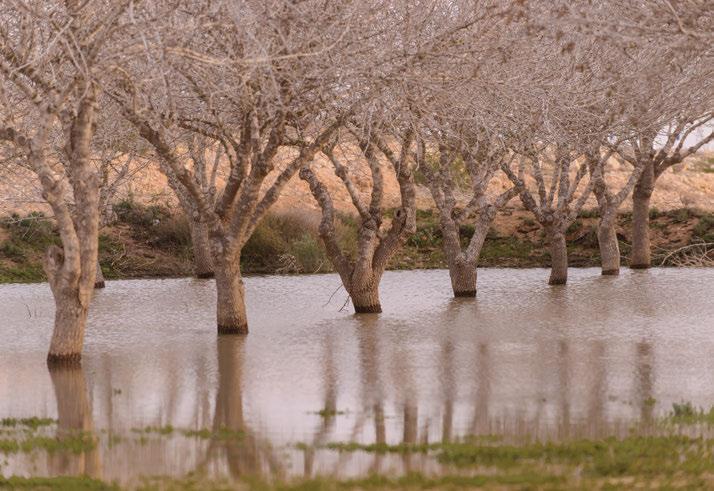
“[A] lot of people do not really understand. [They] see dry lands as some rare deserts, exotic spots in the Atacama [Desert in Peru] or the Kalahari or the Nabib Deserts [in southern Africa],” Weisbrod said. But in fact, arid, often water-challenged areas are much more expansive. They are home to about one quarter of the global population and cover more than 40 percent of the earth’s land mass.
And they are growing every year. “The surface area of dry lands is increasing quite fast due to the intensive desertification processes,” Weisbrod said. What’s more, scientists are finding that climate change is helping to intensify the desertification process in dry land areas. “[That is] why dry lands is an uppermost concern, I would say, even for the future of humanity. [The phenomena] isn’t something rare. It’s something really central and really sensitive.”
Weisbrod isn’t alone in his perspective. Last August, the International Panel of Climate Change (IPCC) issued its latest climate assessment. Scientists and governments from 195 countries weighed in on the interaction between climate change and phenomena such as desertification, noting in its preliminary
report for policy makers that, “Climate change exacerbates land degradation, particularly in low-lying coastal areas, river deltas, dry lands, and in permafrost areas.”
According to the IPCC’s findings, “People living in already degraded or desertified areas are increasingly negatively affected by climate change.” And those living in areas not considered to be dry lands, like the west coast and in the mountains of western Canada that normally get plenty of rain, will be affected, as well. The recent “heat dome” that visited the northwestern United States and Canada is an example of changing climatic conditions.
So, reducing net carbon emissions will be critical to maintaining global warming below 2 degrees C (measured as 2 degrees C above preindustrial levels) and further land degradation, said the IPCC.
Weisbrod said it is difficult to speculate, based on the IPCC report, how much temperatures will rise in a given region or exactly what that might mean, say, for the Vancouver Mainland or interior cities like Edmonton, AB or Chicago, IL.
“We are talking about a simulation, trying to predict the future,” Weisbrod said. “Obviously,
there are numerous variables in this equation and a high level of uncertainty. The best scientists and experts are working intensively on the IPCC report, and I do not think I can provide any minimum or maximum values—this would be irresponsible from me as a scientist.
“What we know, for a fact, is that temperature is rising, and that net zero ASAP is essential to change the current, scary, trend. Therefore, we need to set a goal to emphasize the urgent need to dramatically reduce emissions, and this is what the IPCC report is doing.”
Asked how the IPCC report might affect BGU’s research and academic pursuits, Weisbrod said the report underscores the importance of BGU’s ongoing work. “The IPCC report is emphasizing the urgent need for our research and is giving us another boost to push forward and come up with more ideas, further development, and a deeper understanding of climate change and its impacts on the future of humanity. It is also emphasizing the need to train and educate the next generation of scientists and decision makers in these topics. It demonstrates that these issues are crucial for the future of all of us.”

The SSCC's’s mandate is to sufficiently equip graduates with an interdisciplinary expertise in climate change and further research in related topics. Chamovitz acknowledged that the researchers of today won’t be able to solve all the environmental challenges of tomorrow. It will take future scientists, entrepreneurs, educators, and forward-thinkers with a broad understanding of the environment to address problems not yet seen. And it will take students who have been trained in multidisciplinary fields and innovative approaches.
“[Not] everyone who graduates is going to be a researcher,” Chamovitz said. “We need, for example, engineers who are fluent in public policy problems dealing with sustainability regulations. [We need] policy people who understand the language of genetic manipulation. But we also need people in agriculture who understand the complexities of public opinion and of regulation. It is our graduates that are going to be at the forefront of this, whether in industry, research, government institutions, or NGOs.”
To address that challenge, SSCC graduate programs are being designed to promote and support interdisciplinary specialties. A student who wants to study health issues caused by desertification, for example, would be able to cross-train in health sciences and desert research—two entirely different faculties and sciences—to accomplish their unique specialty.
According to Weisbrod, roughly 70 percent of the university’s researchers are involved in projects related to climate change in one way or another. That includes faculties that aren’t under the umbrella of SSCC. Building a graduate program that is supercharged by that diversity opens the door to even more research on sustainability and climate change—and more partnerships with other universities and organizations that are also trying to address climatic issues as they emerge.

LEFT TO RIGHT:
A liman is an earthen dam that collects floodwater in a gully or riverbed. Trees planted in the liman are irrigated by the floodwater. An overflow channel regulates and allows excess water to escape.
A graduate student from Blaustein Institutes for Desert Research teaches kids in Western Uganda how to grow food.
Prof. Noam Weisbrod with new equipment to study the impact climate has on radon emissions from soil.
The Jacob Blaustein Institutes for Desert Research is already working with the Palestinian Authority and the government of Jordan to foster research, promote water-sharing, and decrease water scarcity in the region. It’s also working with communities in drought-impacted India that need better irrigation and food production systems. Most recently, it’s joined forces with Northwestern University in Illinois to address water quality issues in the Great Lakes.
Weisbrod is cautious when asked if BGU and the Blaustein Institutes will be able to help advance food production on a global scale.
“You know, there are no miracles,” he said. “There is a lot of research here, as I mentioned, on how to get more crop per drop of water. But for my humble opinion, there is no magic here. It’s a lot of work, a lot of patience.”
Still, he admits, BGU’s half-century of research in the Negev Desert is now paying off. “[Folks] that visited the Negev Desert, say, 20 years ago, would be really surprised to see a lot of new farms, a lot of agriculture.”
There are new ways to graft tomatoes and potatoes together to increase a food with tolerance to salt water, better methods to reclaim water, bold new foods, and a thriving Negev wine industry.
David Ben-Gurion’s astonishing claim that Israel could one day make the Negev bloom is coming true. And the technology it yields may offer researchers the best clue yet as to how we will navigate the worrisome impacts of climate change.
More information about Ben-Gurion University of the Negev’s School of Sustainability and Climate Change can be found at: bgu.digitaler.co.il/ BenGurion-school

Just a few weeks after the American capitol was stormed by a mob of extremists, and one year after the first case of COVID-19 was reported in Canada, 231 climate activists and concerned citizens from British Columbia met online to discuss the impending climate crisis.
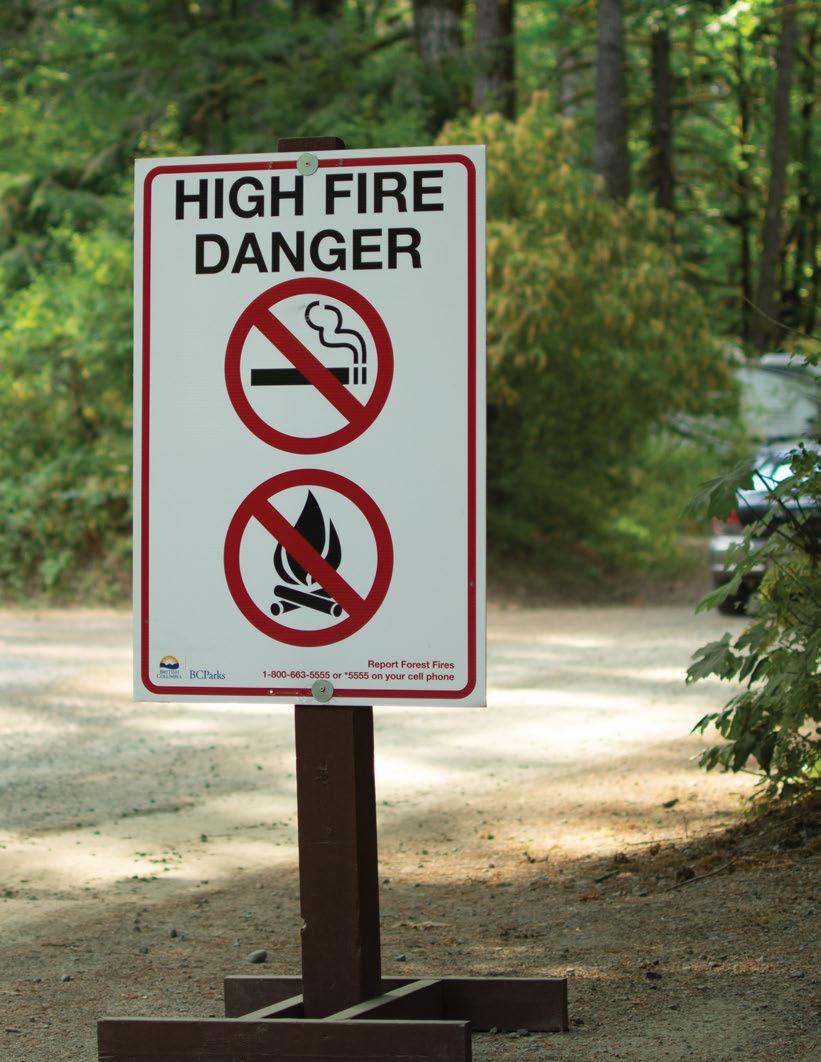 Image of a high danger fire area at Stoltz Pool in Lake Cowichan, British Columbia. Photography: Erin Blondeau.
Image of a high danger fire area at Stoltz Pool in Lake Cowichan, British Columbia. Photography: Erin Blondeau.
It was a typical cold and wet January in the southern half of the province, and frozen and icy in the north. The group of activists, which would later take the name West Coast Climate Action Network (WE-CAN), had no idea how timely their meeting would be. In just a few months, British Columbia would be at the center of the hottest summer ever recorded, with the infamous ‘heat dome’ of 2021 killing over five hundred people and one billion sea creatures. The subsequent hot summer days fuelled wildfires that rained ash across the province.
The first meeting was attended by well-known figures in climate activism circles, like Tzeporah Berman, Seth Klein, David Suzuki, and Elder Geraldine Manson of Snuneymuxw First Nation, endearingly called Auntie Geraldine by many. Small boxes of concerned faces filled the computer screen as the first WE-CAN meeting began—this is activism in the age of COVID-19.
Seth Klein opened by stating that British Columbia does not have a climate emergency plan. How can this be? The climate crisis can no longer be avoided because it’s staring us right in the face.
Author, activist, and board director Guy Dauncey is one of two original WE-CAN directors still with the organization (along with Dr. Heather Baitz).
“We formed five teams,” Dauncey reminisced about the outset of the climate network, which has now grown to nearly 50 volunteers and over 150 member organizations. It’s clear this network is the embodiment of Dauncey’s work for the last three decades. “We formed a board team to do all the administrative stuff. We formed a climate solutions team. We formed a members team and a learning team.”
As a board director (one of two youth and one of two Indigenous directors), I have been able to witness these dedicated teams in action. The diversity among volunteers is an inspiration to me; people from different ethnic groups, ages, and abilities have come together to confront environmental issues through an Indigenous lens, respecting and prioritizing the calls to action by the United Nations Declaration on the Rights of Indigenous Peoples (UNDRIP).
Although diversity and respect are the glue that keep WE-CAN together, a mutual fear of calamity inspired the convergence of activists.
Clinical psychologist Dr. Baitz told me over the phone about her journey to recognizing the climate crisis. “The more I read, the more alarmed I became,” she reflected. “I got very anxious. It was keeping me up at night. I had a six-month-old baby at that point.”
Listening to her story brought a troubling image into my mind: my son’s face. I remember swimming at our favourite spot this summer with a hazy red sky above us, while breathing in harsh polluted air from wildfires. I can’t help but wonder if he will suffer endlessly hot summers here, as he grows up in what is supposed to be the Pacific temperate rainforest. I am concerned that he will not have the opportunity to experience the ancient old-growth forests or swimming in the icy cold rivers. Most importantly, I worry that he won’t have a chance at a healthy life because of our inability to make the paradigmatic shift needed to avoid a complete collapse of biodiversity.
Like so many others, Dr. Baitz started her journey to climate action by scouring the internet. She knew she had to do something, but she didn’t know where to look. I felt the same way in my own search. There is a new type of fear that takes hold during moments like these—knowing something must be done while at the same time realizing there is nowhere to go.
I’ve found that the greatest challenge in taking action against climate change is the lack of collaboration between environmental groups. Making
matters worse are new mental and emotional disorders, like eco-anxiety and climate distress that are not yet commonly known.
Casey Stein, the other youth board director aside from me, is a serial climate activist, studying philosophy, economics, and political science at UBC-Okanagan. Over a phone call from his home in Texas, he explained to me that he also struggled with depression and anxiety in school.
“If there’s one word, it’s frustration,” Stein said. “We’re causing a mass extinction. And you know, people don’t bat an eye.” It’s this mutual frustration felt by all WE-CAN teams that continues to light a fire underneath us (literally) to keep us moving forward.
Speaking to the other board directors of WE-CAN gave me a profound sense of inspiration and an equally strong sense of shame. My own journey to accepting climate change began with denial. Although I was not mature enough to understand it, I held onto anthropocentrism throughout my adolescence. This type of thinking, also known as human supremacy, blinded me from understanding the importance of traditional Indigenous knowledge, like twoeyed seeing and seventh generation thinking. Because I thought of humans as the most important thing in the universe, I found no need to consider the environmental implications of our actions. Tidbits of information in high school reaffirmed these beliefs. In particular, I remember watching the classic documentary, An Inconvenient Truth in high school.
“I want you all to remember that you can make up your own minds on these kinds of topics,” our English teacher told us. This type of dismissal was enough reassurance for me that I didn’t have to believe in this scary new reality.
As time went on, I started experiencing the impacts of a changing climate: dwindling salmon populations in the Quw'utsun River, thousands of dead fish washing ashore, birds falling dead out of the sky from starvation. My most profound moment of change happened during an environmental sociology class. Thanks to my professor’s assignments of Naomi Klein documentaries, I began to face how dire this situation really is. Unfortunately, as I started reaching out to other climate groups, there was a lack of response and enthusiasm. I was prepared to volunteer every day if I had to, but no one seemed to have a plan.
The teams at WE-CAN also recognized this issue and began reaching out to connect all existing environmental and climate organizations in British Columbia with the goal of creating a more concise and networked approach to mitigating climate catastrophe. WE-CAN has become a place of refuge for me during times of climate distress, while at the same time being a place to make change.
“We’re building the sense that we’re a family,” Dauncey told me. “We’re not just people at a meeting, getting stuff done.”
Since working with WE-CAN, I’ve regained my faith in our ability as Canadians to shift the climate paradigm. We don’t have time to wait for governments and corporations to change—we must be the change. WECAN has demonstrated that one of the best ways to make big changes is by working together.
Alison Bodine, board director and a central organizer with Climate Convergence, summed up the essence of WE-CAN to me in an email:
“It’s not only a new climate organization, but more importantly a space that will elevate the important work of hundreds of climate action groups across BC, and facilitate groups and individuals finding common ground for action and working together. In unity, we win.”
To learn more about the West Coast Climate Action Network and to stay up to date with its initiatives, visit www.westcoastclimateaction.ca
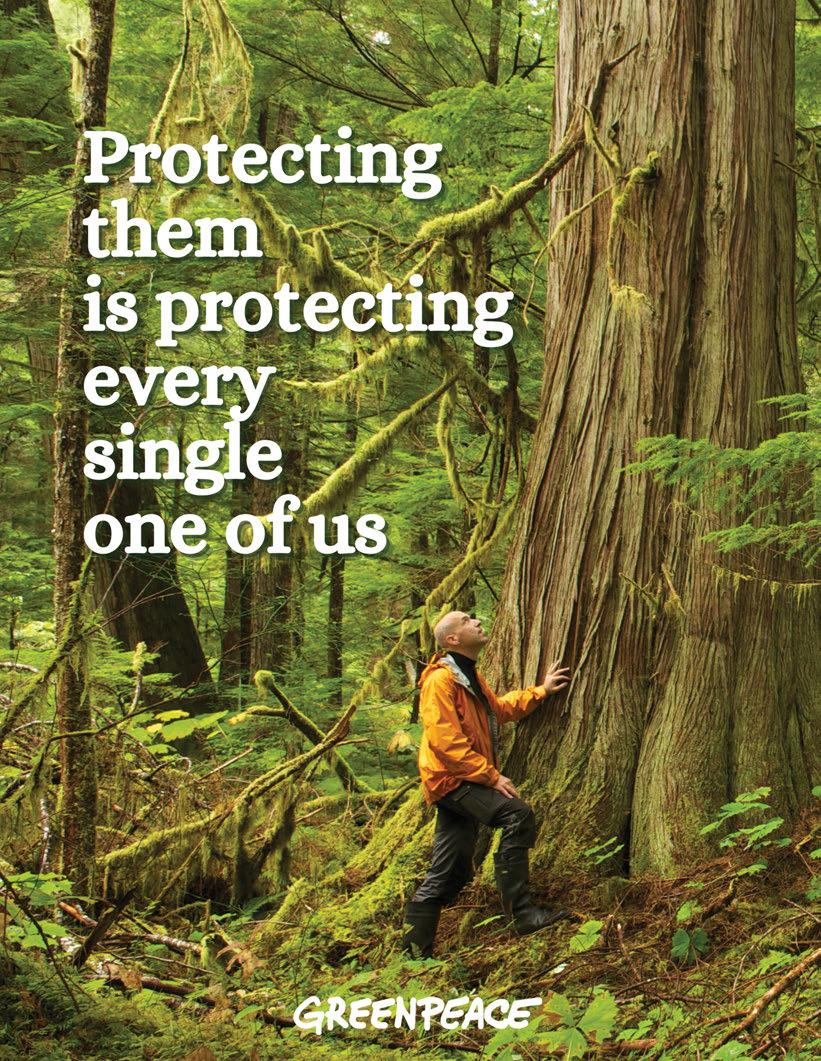
Sustainability encompasses the value of continuous improvement, as these Canadian businesses have shown through their strong leadership and commitment to do better for their customers, communities, and the planet. They don’t just talk about sustainability as an idea—they live and breathe these business practices day in and day out, looking for new ways to innovate and create change from within. GreenStep is proud to have worked with these companies throughout their sustainability journey, and we look forward to celebrating their achievements together in the years to come. -
Angela Nagy, CEO.Eagle Wing Tours is an award-winning, inclusive Victoria-based ecotourism and conservation company offering year-round whale and wildlife watching tours.
Our mission is to protect marine wildlife and the ocean environment through direct support of conservation and research activities, to build ocean awareness through education and outreach programs, and to promote environmental stewardship through industry-leading sustainability initiatives.
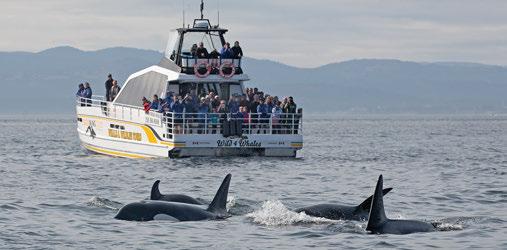
Eagle Wing is a long-time member of 1% for the Planet. We’re also Canada’s first and only third-party verified 100% carbon neutral whale watching company, and Victoria’s #1-ranked whale watching company on Trip Advisor since 2007.
Sustainability and environmental stewardship have always been core values at our company. We operate fuel-efficient, low underwater noise vessels. We use a green purchasing policy. We practice the five Rs of waste management. We’re the first whale watching company in Canada to be certified Platinum with GreenStep Sustainable Tourism. We’re certified Green for our green business practices by the Vancouver Island Green Business Collective, and we’re Surfrider Approved as an ocean-friendly business
We’ve also taken the Sustainable Tourism 2030 Pledge, which publicly demonstrates our commitment to improving our sustainability score between now and 2030. We support the UN Sustainable Development Goals, with a special focus on six goals. And we’re ready to embrace regenerative tourism, which encourages visitors to respect, restore, and protect the unique marine environment and cultural heritage of the Salish Sea.
For more information on our sustainability and conservation initiatives visit the Conservation section of our website at www.eaglewingtours.com


Whether you're travelling with friends, family, or colleagues, Elmhirst's Resort in Keene, Ontario, is an exemplary four-season cottage resort and vacation destination rife with gorgeous scenery, unrivalled hospitality, and seemingly endless opportunities for outdoor exploration and excitement in the Kawarthas.
Elmhirst's Resort offers a spa, excellent dining, and a host of activities for the whole family. The collection of 30 cottages is nestled on the beautiful north shore of Rice Lake. Managed by a fourth generation of Elmhirst family, with a fifth generation living onsite, Elmhirst’s continues to offer the very best of the Kawarthas—much of it grown or raised from their very own 240-acre property or sourced nearby.
“Sustainability has always been an important part of the way Elmhirst’s Resort conducts its business activities,” said Greg Elmhirst, general manager. “The GreenStep Sustainable Tourism certification validated much of the work we have done so far but also highlighted some important next steps. Applying a clearer focus to measuring key energy, environment, and social impacts, setting goals to sustain consistent improvement, and getting everyone involved on both sides of our guest relationships will amplify the work we have done already. The changes caused by the unprecedented challenges of 2020 create an opportunity to look at Elmhirst’s Resort in new ways and implement new solutions.”
Elmhirst’s Resort Sustainable Tourism 2030 Pledge: Elmhirst’s Resort has signed the Sustainable Tourism 2030 Pledge to demonstrate our commitment to improving the sustainability performance of our business between now and 2030. The UN World Tourism Organization defines sustainable tourism as “tourism that takes full account of its current and future economic, social, and environmental impacts, addressing the needs of visitors, the industry, the environment, and host communities.”
Some of the sustainability action-plan items that Elmhirst’s has undertaken include:
• Developing a Sustainability Policy outlining our commitment to measuring the environmental, social, and ecological impact of our business activities so that goals for consistent ongoing improvement can be set and achieved.
• Commitment to achieving optimal efficiency in consumption of water and energy inputs with reduction of waste outputs. Including new highly efficient HVAC system installation in all 30 cottages.
• Implementing the Sustainable Purchasing Action Plan, focusing on fair trade, local, and sustainable products.
• Increased stakeholder engagement in the sustainability action plan, including guest, staff, and management participation.
www.elmhirst.ca/sustainability
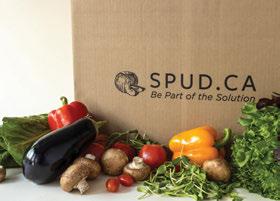
At SPUD and Be Fresh, our goal is to create relationships with amazing farmers, ranchers, fishermen/women, bakers, and artisans, to make it easy for you to have the freshest ingredients and amazing products delivered directly to your home or office.
We believe that food should be healthy, so we partner with local producers and farmers who you can trust—real people who have integrity, who respect our environment, and who care about our community, people who value sustainable farming practices and believe in the humane treatment of animals.
We select local ingredients from partners who care about your food and our environment. Since we started in 1997, we’ve been committed to providing simple access to real, healthy, local food.
Here’s our checklist.
• Practise or actively support organic and sustainable growing methods that respect crop diversity and soil health, avoiding the use of pesticides.
• Display a deep commitment to the local community.
• Be transparent about product ingredients and sources, prioritizing local when possible and avoiding the use of artificial components like high fructose corn syrup.
• Remain GMO-free.
• Provide safe, fair working conditions for food producers.
• Respect ecological habitats and animal welfare by fishing responsibly to prevent resource depletion and providing ample grazing space for livestock. Animals must be raised without the use of growth hormones or antibiotics.
SPUD is proud to be a certified B corporation, a new kind of company that uses the power of business to solve social and environmental problems. Learn more at http://about.spud.com/ourmission/sustainability
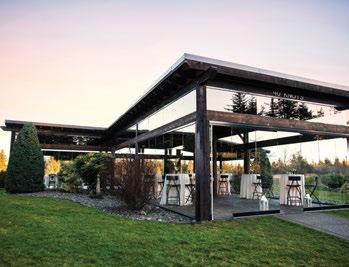
Located in beautiful Comox, BC, on Vancouver Island, 40 Knots Winery embraces our unique microclimate on the slopes of our vineyard that faces the Georgia Strait. We were recently reassessed with GreenStep’s Sustainable Tourism and achieved the highest grading level to become Sustainable Tourism Platinum Certified.
At 40 Knots Winery, we choose to farm and craft wines based on sustainability. That means we take the best of traditional, vegan, organic, and biodynamic methods to our vineyard and cellar. It is in our business mission and vision to be sustainable: economically, environmentally, and socially. Our strategic plan is inclusive of all these. It not only makes business sense because this is what our customers expect; it makes sense to do our part to ensure healthy soil, air, community, and world.
“People think that being sustainable is costly, but in fact the opposite is true,” said Brenda Hetman-Craig, owner of 40 Knots Winery. “Incorporating sustainability creates a fiscally responsible business in addition to all the positive impacts in your community and beyond.”
We are continually working towards zero waste, continuing to add farm-fresh food to our picnic offerings, and our entire team is working with us and constantly coming up with ways we can be more sustainable.
We will continue to grow our gaggle of geese from 20 to 50 by natural hatching. We are expanding farmland, planting another 5 acres of vineyard, expanding our orchard by adding 500 dwarf apple trees, and reclaiming a 7-acre vineyard on Quadra Island. We are growing our partnerships with other like-minded producers, and we are committed to buying local.
We continue to support the work of Project Watershed to reclaim the Comox Estuary, and work to improve our vineyard interpretive trail. For more information, visit www.40knotswinery.com

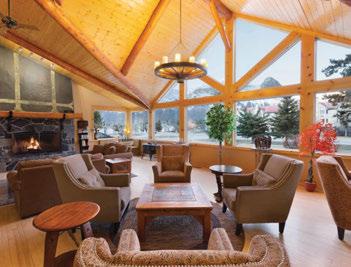
INNHotels is a Canadian group of companies specializing in tourism, hotels, resorts, and outdoor adventures since 1971. With properties located in Jasper, Invermere, Grande Cache, Valemount, Red Deer, Stony Plain, and Canmore we provide a variety of services to guests throughout Alberta and BC.
As the world’s concern for a healthy planet continues to grow, INNHotels has made a commitment to be a leader within the hospitality industry for sustainable management and corporate responsibility. We have formed a team of dedicated and inspired individuals who have come together to help change the way we conduct business on every level. This is our GoINN Green promise to our communities, guests, and families.
To celebrate Earth Day this year, our team partnered with West Coast Seeds and put together packages of wildflower seeds to help attract our precious pollinators. The seeds were handed out to our guests and staff, and everyone was encouraged to plant them within our local communities. The bee seeds were a huge success and likely something our guests have not experienced at a hotel before.
As we move forward with our vision of GoINN Green, we have partnered with several organizations, including GreenStep Sustainable Tourism. With GreenStep’s help we are able to create a sustainability strategy, which will help us measure and improve our practices at each location, reduce our carbon footprint, and go greener with our development while still providing exceptional service throughout our organization.
Other initiatives we have begun to implement throughout our properties include our partnership with Soap for Hope, switching from paper to digital processes whenever possible, and moving to suppliers who are also working towards more sustainable practices. We look forward to continuing our mission of becoming part of the solution for sustainable management and corporate responsibility. Learn more about us at www.innhotels.com
We are a British Columbia-based kayak company that offers multi-day tours in a variety of tour styles, including base camp, expedition, mothership, and family tours. Our primary goal for all our tours is to connect guests with the incredible beauty and wild wonder British Columbia has to offer, provide engaging environmental education and, ultimately, inspire them to protect it.
We aim to be a leader in responsible and sustainable tourism and business practices. We strive to continually assess ways we can minimize our impact, improve our operations, and contribute to the communities in which we live and work. All aspects of our tours are thoroughly investigated and considered from the choice of campsite, camp layout and location, material used in construction, carbon output of getting materials to a remote location, partners we work with to provide services, the food we serve, the staff we employ, what we communicate to our guests, and so on.
Some of our more notable environmental initiatives include being members of 1% for the Planet, which means that 1% of all our sales get donated to environmental non-profits. We have also achieved Gold Certification from GreenStep Sustainable Tourism, which audits and assesses the sustainability of our organization. Most recently, we have been selected to lead a Marine Debris Removal project in the Discovery Islands as part of the BC Government’s Clean Coasts, Clean Waters program this fall. Through this project, we will tackle the collection of debris in hardto-reach places as well as recycle and divert as much as possible from the landfill.
To learn more about us and our environmental initiatives, please visit www.kayakingtours.com

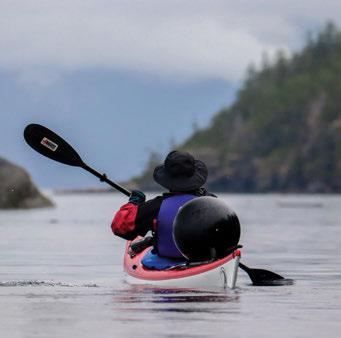
Prestige Hotels and Resorts is one of BC’s finest family-owned chain of resorts, hotels, and inns. With a passion for excellence and an uncompromising commitment to superior service, we invite visitors to experience beautiful British Columbia complemented by our unique brand of hospitality. Located throughout the Interior of British Columbia and on Vancouver Island, each resort, hotel, and inn offers the opportunity for a truly unique regional experience.
Prestige Hotels and Resorts prides itself in being an integral part of the communities that we are a part of. We believe that our luxury hotel experience is enhanced by our beautiful surroundings, and therefore we will continue to ensure that we are playing a vital role in sustaining that beauty so we can continue to welcome guests to enjoy the diverse communities of British Columbia.
All Prestige properties are GreenStep Sustainable Tourism Certified, with almost all properties having achieved Silver. This certification measures our success in meeting a wide range of sustainability criteria and indicators that are aligned with the UN World Tourism Organization and the Global Sustainable Tourism Council. This certification must be renewed every three years ensuring that sustainability practices and improvements stay front of mind. Additionally, we offer the Go Green Program at all our locations, which allows our guests to forgo housekeeping services in exchange for a $10 voucher to the on-site restaurant or 1,000 Prestige Reward points. To Go Green helps offset our daily water, power, and detergent usage, thus reduces our environmental impact. In 2021, we also started our sustainability committee meetings at every single property, encouraging and empowering front-line employees to make a difference.
For more about Prestige Hotels and Resorts and their sustainability practices, visit www.prestigehotelsandresorts.com

Taking care of the planet is our guiding philosophy at Siwash Lake Wilderness Resort. While crafting our world-class eco-lodge and luxury guest ranch, our focus has always been striving to be true stewards of the land. Since we became guardians for this precious piece of wilderness at Siwash Lake more than 30 years ago, it has been our mantra to stay in harmony with the surrounding environment. We've practised green tourism for more than two decades.
While drawing inspiration from nature and the ancestral culture of the area, our luxury resort has grown with the land, not onto it. We partnered with National Geographic for many years on a mission to promote sustainability through tourism, help our clients understand the effects of climate change, and inspire them to follow in our green footsteps. Following an extensive sustainability audit, we recently became a Platinum certified business by GreenStep Sustainable Tourism.
Learn more about our sustainability initiatives at www.siwashlake.com/about-us/sustainability.tml
Pela creates Everyday Products Without Everyday Waste™, starting with the world’s first compostable phone case. Pela is on a mission to create a wastefree future and, more specifically, eliminate one billion pounds of waste from ever being made by 2028. Since launching in 2011, Pela has helped over one million people make the switch from plastic to plant-based alternatives.

tentree
We plant ten trees for every item purchased. We’re a rapidly growing, sustainable apparel brand for those who identify with the outdoors but are not defined by it. We motivate and encourage environmental stewardship through Earth-First apparel.

To date, Pela has saved our waste streams from over half a million pounds of plastic and has donated over $500,000 to charitable organizations making our world a better place for both the planet and its people. Pela is Certified Climate Neutral, a Certified B Corporation, and member of 1% for the Planet.
In the past year, Pela has extended its offerings from eco-friendly device cases to a community of brands that work together toward the company’s end goal. Swway creates sustainable sunglasses and blue light frames; Habitat creates zero-waste, vegan self-care products; and Barxby creates cruelty-free, zero-waste pet care products, with pet wear and play products coming soon. Pela’s most recent venture, Lomi, is a countertop composter that can turn your food waste into nutrient-rich soil for your plants in a matter of hours. Lomi has the potential to reduce every household’s waste by up to 50 percent.
Pela is on a mission to create a sustainable future for all, and its plant-based phone case was just the beginning. Find more information at https://pelacase.com/ sustainability-strategy/our-footprint
Everything we do stems from how to do better by our planet—like planting trees. We plant trees because it’s one of the best ways to create a more sustainable future. But over the years, we’ve realized that our journey doesn’t start and end with planting trees. We’re constantly looking at innovative ways to make apparel with the smallest possible footprint and create more circular supply chains. The fashion and textile industry is considered one of the top polluters, and one of the heaviest natural resources consumers in the world. To give you some context, a tentree sweatshirt uses on average 75% less water to make than the other sweatshirts in your closet. We’ve committed to finding and sourcing the most sustainable fibres and materials available. It’s not only our responsibility to ensure we leave the smallest impact on our environment; we also take great pride in finding better, healthier, and more eco-progressive solutions for our customers.
Earth-First is our commitment to making choices in a world where the planet and its people come first, always. We’ve planted over 50 million trees with the support of our growing community, and we’re on an exciting mission to plant 1 billion by 2030.
Visit www.tentree.ca

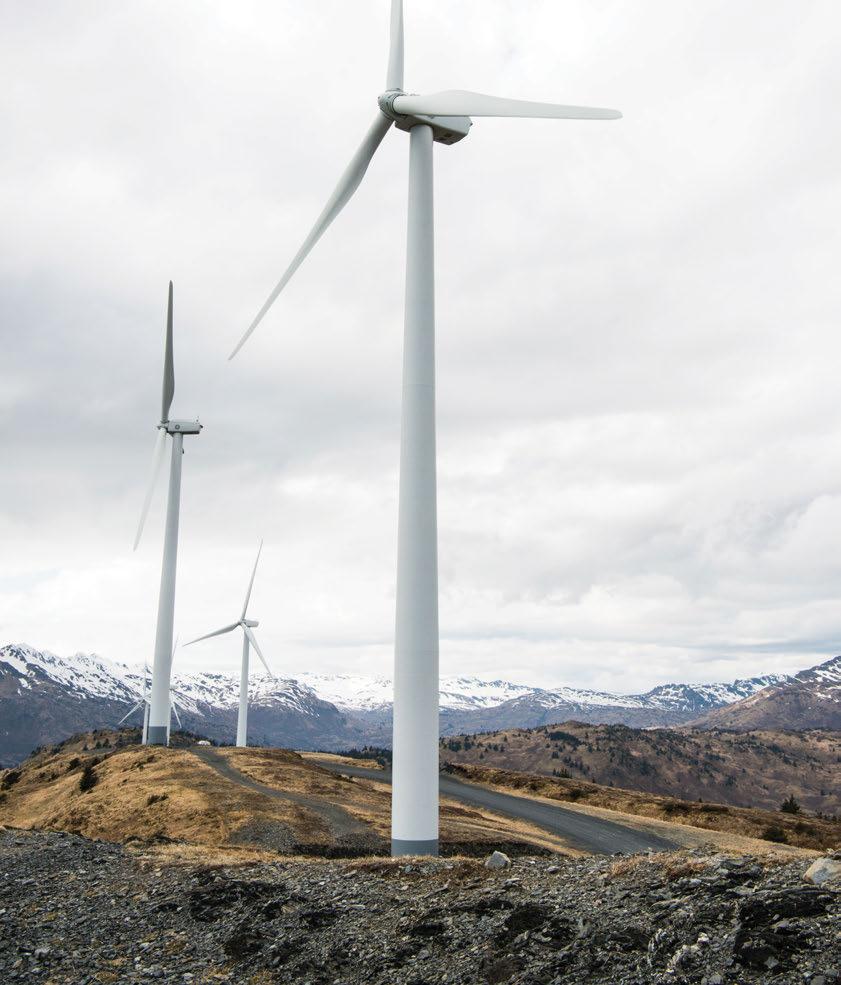
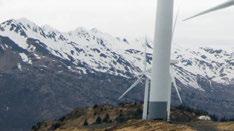
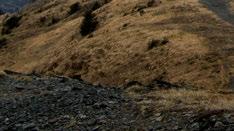






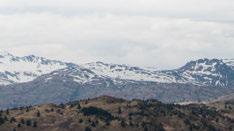
GreenStep is on a mission to support businesses and organizations
their sustainability journey, to help reverse the effects of climate change and protect our planet and communities for future generations to come.
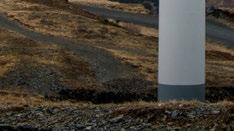


Greenstep provides expert solutions to measure and improve your sustainability performance, that benefit the planet and your bottom line.

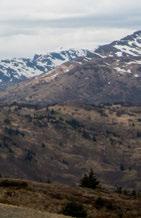
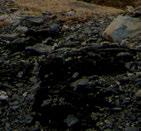

Welcome to Saving Earth Magazine's leadership interview series. A candid conversation with industry leaders on the growing influence, relevance, and competitive advancement of sustainability in business and our personal lives.
Our guest this edition is Geoff Pegg, head of sustainability and environment at TELUS. TELUS is one of Canada’s largest telecommunications companies with more than 40,000 employees and, importantly, a strong commitment to environmental stewardship and sustainable innovation. Geoff also serves on advisory boards for several organizations committed to advancing positive environmental and social change.
Geoff has led TELUS’s sustainability team in the establishment of transformative climate change targets, including TELUS surpassing its 2020 climate change goals; achieving a 15 percent reduction in energy use compared to the 10 percent target, and a 31 percent reduction in GHG emissions compared to the 25 percent target. Geoff was able to push for even bigger targets: to have operations be carbon neutral by 2030 and to procure all electricity from renewable sources by 2025. He has also negotiated TELUS’ four renewable electricity Power Purchase Agreements to procure renewable energy from three solar farms and a grid-scale wind farm with no government subsidies.
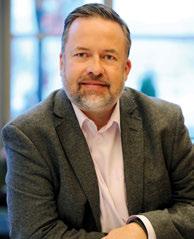 head of sustainability & environment for telus
head of sustainability & environment for telus
In 2020 alone, TELUS was recognized on The Wall Street Journal’s list of Top 100 Sustainably Managed Companies; the Dow Jones Sustainability World Index; the Dow Jones Sustainability North American Index; Corporate Knights’ Best 50 Corporate Citizens Canada, and the Top 100 Most Sustainable Corporations in the World, and it was awarded a Global Compact Network Canada’s SDG Accelerator Award. For 2021, it’s already been named as one of Canada’s Greenest Employers by the Canada’s Top 100 Employers project.
As a sustainability leader in a leading technology sector organization can you provide some thoughts on the growing relationship between technology and sustainability?
Without a doubt there is a growing relationship between technology and sustainability. At TELUS, we incorporate and measure sustainability throughout our business operations, including developing new technology to support customers. A great example is TELUS’ Ag-tech division that leverages technology innovation to help farms produce higher yields for their crops, while minimizing energy and resource use. This ensures that farms can produce food for the world’s growing population more efficiently and in a more environmentally responsible manner.
Another example is TELUS’s Trees for Paper program, a partnership with Tree Canada, where we focus efforts to reduce our environmental impact and advance sustainability. TELUS has also contributed more than $20 million to charities and community organizations that support the environment. TELUS promotes a no-fee recycling program for old cellphones, batteries, and laptops, available at TELUS drop-off locations across Canada. In terms of our Canadian peers, our plan is unique as we’re not taking the approach of buying offsets. We’re actually building capacity with technology that elevates sustainability. We have several energy management initiatives in place and a real estate optimization program, which leads to a balanced approach to decarbonization where you’re not just buying your way out.”
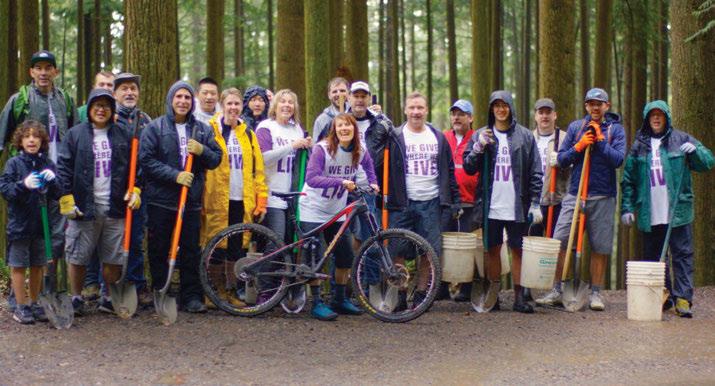
Beyond supporting the environment, how is TELUS leveraging the value of sustainability to support customers, community, and its own business objectives?
TELUS is a publicly traded company, so the voices of our customers, shareholders, and board of directors provide important feedback. We recognize that customers today prefer doing business with organizations committed to supporting the environment. At TELUS we proudly share our environmental goals, progress, and reporting with customers and community stakeholders.
We also incorporate sustainability in developing new technology, helping customers measurably reduce their footprint for their business operations and lifestyles. As a leading corporate citizen, we simply believe that by improving our environmental performance, our business, our partners, and ultimately our customers, all benefit. Sustainability also helps us gain a competitive advantage for attracting customers, employees, and investors.”
Many large organizations today proudly and publicly communicate their commitment to the environment; however, sustainability leadership continues to remain absent in most C-suites that continue to house CEO, CFOs, COOs, CTOs... even the abbreviation CSO is used mainly for Chief Security or Strategy Officers. What are the next important steps we need to take to ensure that every C-suite has a Chief Sustainability Officer?
The growing influence, competitive advantages, and compliance requirements related to sustainability will continue to create more leverage for sustainability leadership at the C-suite level. Equally as important, sustainability is a growing topic of discussion at the board of directors level. Boards must now focus on effectively stewarding the growing risks and opportunities associated with environmental, social, and governance issues. I truly believe all the above factors will inspire a new generation of leaders that will combine both leadership skills for advancing sustainability and business strategy. These leaders will increasingly be included in C-suites around the world.
Beyond careers specifically focused on sustainability, how will sustainability impact other career choices for professionals that are currently in or about to enter the workforce?
This is a topic that I have been involved with for many years as a teacher and guest lecturer at various levels of education. Today’s students and young professionals are strongly aligned with the value of protecting the environment in pursuing their personal and professional goals. By 2025, the Millennial generation and employees under 30 will make up more than 50 percent of the workforce. Their interest and passion for protecting the environment will evolve all job titles and organizational policies related to sustainability. I also think the growing influence and competitive advantage of sustainability will impact how and who organizations will hire.
The future of recruiting talent will incorporate screening for candidates with the interest and capacity to support sustainability objectives and policies. At TELUS, we include a social capitalism index in our corporate scorecard. This measure incentivizes employee engagement and activities related to social purpose. TELUS team members, as part of the variable component of their compensation, can contribute and take action on achieving social and environmental objectives resulting in multiple benefits.
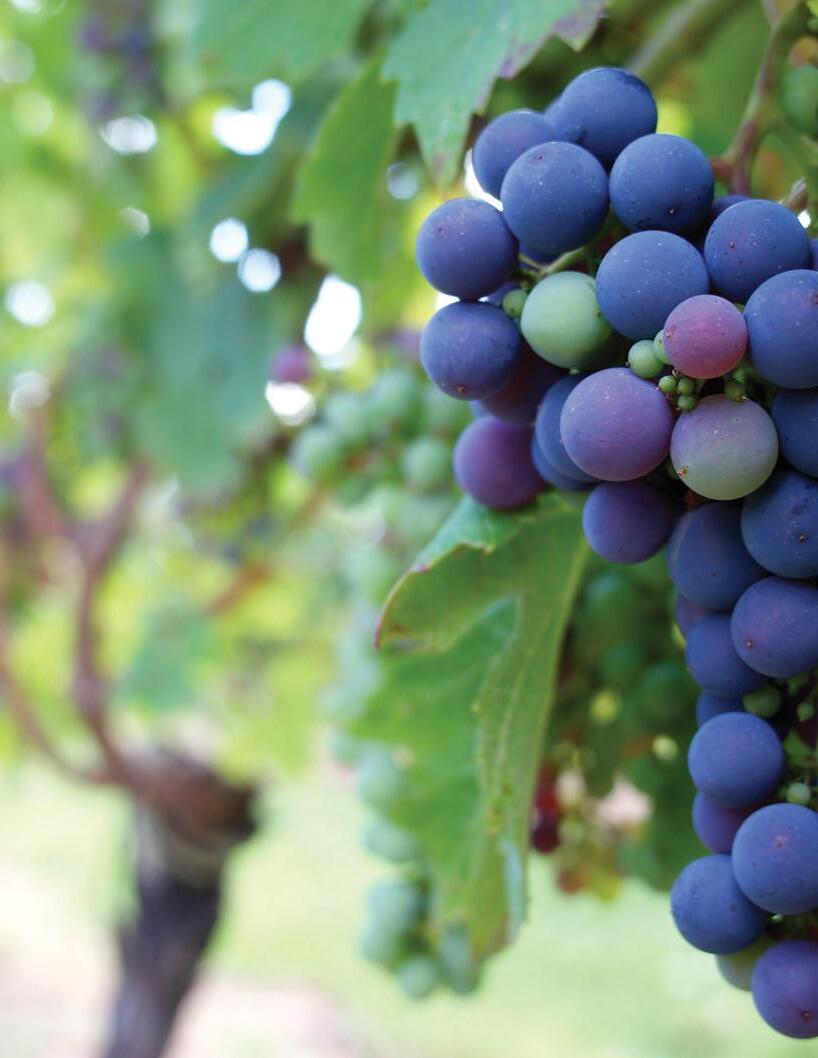 By Roslyne Buchanan
By Roslyne Buchanan
A
that is "better for people, better for the planet."

Enjoying a bike ride between wineries in British Columbia’s Okanagan, Winecrush® founder Bill Broddy had an “Ah-ha moment” when he became inspired by a healthy-looking North American bear he happened upon that was eating discarded grape pomace. The well-fed bear was showing her cubs the deliciousness of this byproduct of winemaking.
For Bill, it was an immediate reminder that even after pressing, grapes remain nutrient-rich with phenolic compounds, fiber, and antioxidant properties due to anthocyanins, hydroxybenzoic acid, and hydroxycinnamic acid contained in the grape skins and seeds. We know the grapes’ juice ends up in beautiful bottles of wine in the Okanagan, and yet typically we don’t think about the leftover bits from the winemaking process. Despite the fine nutritional properties within it, much of the grape pomace winds up in landfills.
Thus, Bill’s revelation resulted in the founding of Winecrush® in 2016 in Canada’s scenic Okanagan wine region to focus on turning high-quality, rich wine derivative material into healthy, nutritional food with alchemic powers.
As Winecrush® spent years working with traditional methods for valorizing winemaking output, Bill came to the realization there had to be a better way. Working with some of the leading wine scientists in Canada, Winecrush® has pioneered a proprietary process for transforming winery derivative into valuable nutrition.
The patent-pending biomechanical process transforms winemaking derivatives (skins, seeds, and sediment) into a puree with exceptional nutritional content, particularly polyphenolic substances, including flavonoids such as quercetin and nonflavonoids such as resveratrol, a powerful antioxidant.
Among its many benefits, the Winecrush® puree enables substantial sodium reduction. When blended in a typical plant-based protein formulation, the Winecrush® puree’s phenolic tannin content can reduce required sodium content by as much as 80 percent.
Given shelf life is an important consideration for food producers, food processors in almost all food categories can benefit from a proven natural preservative that is loaded with all the good things for which red wine is known. Winecrush® puree can be packaged in various ways, including gel caps, dried into powders, or blended in other dietary or nutraceutical formulations.
For every two bottles of wine produced, Winecrush® can create one bottle of pureed edible winemaking derivatives. If you consider the global annual 30 million tonnes of wine production, transforming it into 15 million tonnes of derivative is equal to saving 50 million tonnes of CO2 equivalent emissions.
As Winecrush® points out: “Better for people, better for the planet.”
Winecrush® is located in one of Canada’s rich winemaking regions, giving it the advantage of access to the freshest and highest quality grape pomace. Wineries, too, are keen to act on sustainability while striving to create outstanding vintages. Like all agricultural businesses, wineries are under pressure to consider environmental impacts. Increasingly, these considerations are monetized into government programs, such as carbon taxes.
A quantum leap in sustainable winery practices is possible through a partnership with Winecrush® wherein together a positive impact on
methane emissions and land resources can be realized. Wine derivatives, often discarded at considerable expense, can now be valorized through Winecrush® to create a new revenue stream for the winery and make upcycling much easier.
Upcycling has often been limited to returning byproducts as nutrients to the vineyard, fertilizer for other agricultural use, animal feed, grappa-style liqueur, grapeseed oils, and cosmetics. Benefits of the Winecrush® solution can include methane emission avoidance, waste disposal cost elimination, carbon credits, and winery profile diversification.
"Grape pomace is known to contain grapeseed oil, dietary fibre, protein, and tartaric acid, which has antioxidant and preservative qualities," notes Bill. Accordingly, Winecrush® products have had versatile applications over the years, such as salt reduction, prepared meats, dairy including desserts, cheeses, yogurts, and ice cream, breads, and cereals, as well as seasoning spices, condiments, and sauces to enhance flavour and nutritional value, and act as natural preservatives.
With this new proprietary process, the impact can be expanded globally.
Winecrush® is part of Clean Technology Initiative 2020. It received research and development support from Agriculture and Agri Food Canada and established a dream team of expertise to propel it forward. Clean Technology Initiative has a focus on breakthrough solutions to complex and persistent problems in developing clean technology.
Agriculture and Agri Food Canada awarded funding to Winecrush® for its Marlee Project through its Agricultural Clean Technology (ACT) program. ACT invests in the research, development, and adoption of clean technologies leading to the promotion of agri-based bioproducts.
As part of its pilot program in the Marlee Project, ten Okanagan wineries were engaged to collect their pomace (also known as marc, the grape skins and seeds left after pressing) and lees (the sediment left behind). Through the pilot, 150 tonnes of wine derivative were diverted from landfills, avoiding the release of 6,500 kilograms of methane and creating the equivalent of 175 carbon credits.
Keira LeFranc, winemaker at participant Stag’s Hollow Winery, said, “Winecrush®’s vision for sustainability and environmental preservation seems to be in line with what we are striving to achieve.”
She noted the team has been responsive in addressing questions and concerns and diligent to ensure the process was non-disruptive, easy, and streamlined. “We are excited to partner again for the 2021 harvest and appreciate the focus on environmental sustainability the initiative brings to the wine industry.”
Bill, whose vision it was to incorporate wine derivatives into gourmet foods, spent 15 years in product development and product management at IBM (in Vancouver, BC; Toronto, ON; and Boulder, CO). Winecrush® is his third start-up.
Gary Strachan, head scientist, is an oenological biochemist with over 25 years consulting to wineries. Former head of wine and grape research at Agriculture Canada’s Agrifood Summerland Research Center, he is member of BCWGC Sustainability Committee.
Kirk Moir, CEO, is described as a serial entrepreneur and presently is an executive in residence at Simon Fraser University's Venture Labs. Kirk is a corporate and business development expert who has started, led, and advised innovative high-tech companies and garnered multiple accolades, such as Deloitte Fast 50 and BCTIA - Best Application of Technology.
Allie Broddy, application development manager, has spent the last four years working with wineries, food retailers, and the restaurant industry on ways to infuse winery derivatives into popular food items. She manages product sensory feedback with consumers, culinary experts, and suppliers.
Additional advisors include:
Steve Creed, international expert on valorizing food production waste. Based in the UK, he is the former director of the Oxford-based, worldwide Love Food; Hate Waste program managed by Waste & Resources Action Programme. Steve provides guidance on optimal strategies for commercialization and is developing the Love Wine; Hate Waste certification.
Dan Prokosh, food operations expert and former VP operations of Five Guys Burgers Canada, is currently chef/owner of Black Antler Restaurant, Penticton, BC, and brings more than 30 years’ experience in the restaurant industry to helping Winecrush® develop its reference formulations and sensory testing.
Food producers are continuously responding to evolving needs and preferences of customers and recognize today’s consumers are becoming increasingly more health conscious. “Clean label” thinking guides the choices by many consumers.
Studies have confirmed grape pomace has many health benefits. The nutrients in grapes left over from the vinification process can aid in preventing major illnesses like cancer or Alzheimer’s disease. They can help lower blood pressure, reduce inflammation, and aid in weight loss. See www.ncbi.nlm.nih.gov/pmc/articles/PMC2728695
The polyphenol antioxidants in the powder help protect the cells in the body, controlling the rate of aging and preventing tissue degradation associated with heart disease and cancer. The Winecrush® puree includes other nutrients, such as vitamin E, linoleic acid, gallic acid, flavonoids, phenolic acids, proanthocyanins, anthocyanins, and resveratrol.
Resveratrol is attributed to having high concentrations of cancer fighting antioxidants. Plus, studies indicate resveratrol positively impacts cardiac function, reduces inflammation, lowers LDL (bad cholesterol), and prevents damaged eyesight due to age.
Of course, one of the challenges for food producers is to produce food that is healthier and also tastes good. Given its location in the Okanagan Valley wine region where it can source the highest quality of winemaking derivatives, the Winecrush® puree delivers on this front, too.
Plant-based foods have typically been used in meat substitution, such as plant-based burgers. Primarily sourcing red grapes, the colour is similar to red meats, which is helpful in keeping integrity in the processing. Allie Broddy has also been working closely with some local Canadian food producers to test its flavour and performance in plant-based food formulations. Working with Canadian innovators who have extensive experience in working with consumers wanting to make healthier choices provides the company with immediate feedback.
“We feel Winecrush® is uniquely positioned to take this technology to a global scale and truly impact waste reduction and upcycling these derivatives in ways not previously considered,” says Moir.
To learn more and to explore a partnership, see winecrush.ca



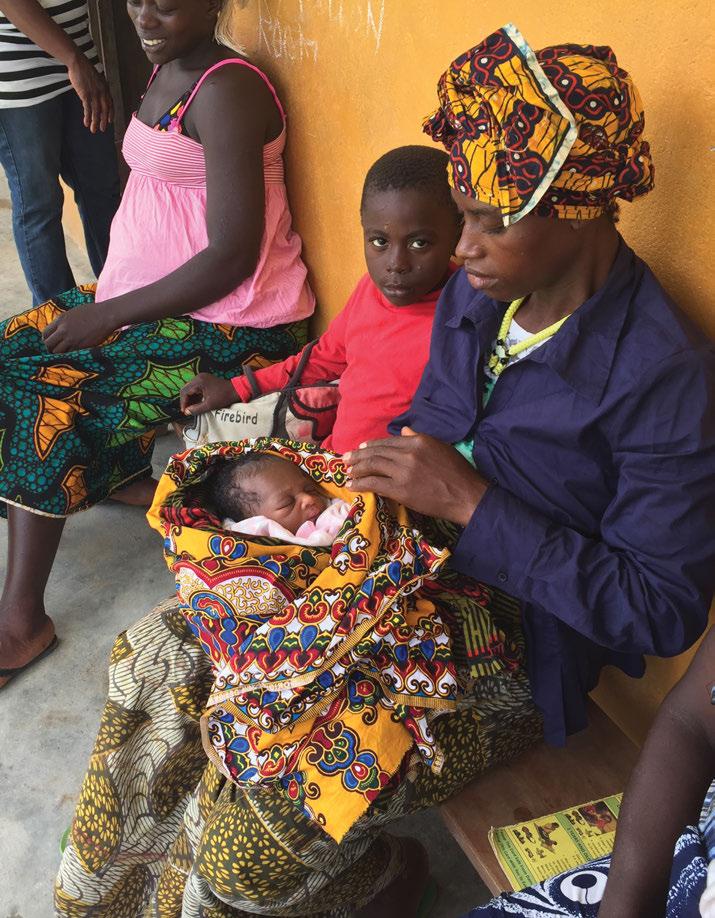
In 2021, there are still millions of people around the world living in small, remote villages that need aid. Far from our daily barrage of worries, they go, for the most part, unnoticed. But thanks to a Canadian non-profit, Village Medical Project for Sierra Leone Society (VMPSL), 24 villages in the Gorama Kono Chiefdom in the Kono District of Sierra Leone are getting noticed and getting the help they need.
The Kono District is known for its diamond reserves and the horrific Sierra Leone civil war that lasted for almost 11 years (1991–2002), leaving more than 50,000 people dead. The scars of war still impact the population. You may remember Leonardo DiCaprio’s performance in the 2006 political thriller Blood Diamond. Based on true events, the film captures the atrocities of a country torn apart by government loyalists and insurgent forces. Almost 20 years later, out of the limelight of Hollywood, Sierra Leone still struggles to take care of its own.
The story of how VMPSL was created to help villagers in the Gorama Kono Chiefdom of Sierra Leone is quite extraordinary. The narrative begins in 1974, long before the civil war, with two young undergraduate students from Elon College in North Carolina, Wes Strickland and Aiah Gbakima. The two students, Strickland studying biochemistry and Gbakima, biology, spent a great deal of time together and soon became good friends. Strickland was impressed with Gbakima’s ideals. He learned of how Gbakima had come from a small village in the Gorama Kono Chiefdom, how he loved his people and his country, and how he came to the United States to study medicine so that he could return home to help his people.
After graduation, the two young men went their separate ways.
Gbakima continued on to study parasitic diseases and molecular biology at the University of North Carolina, completing his PhD in parasitology. Then later, with degree in hand, he returned to Sierra Leone. There he began his research into
(Onchocerciasis). Unfortunately, when the civil war broke out in 1991, he was forced to leave, but he vowed to return as soon as possible.
Strickland followed a different path. After working in cancer research and then as an analytical chemist in marine biology, he moved on to become a businessman and philanthropist. He made his way to British Columbia, Canada, where he continues to live today.
The phone rang one afternoon in 2006. Strickland would hear from his dear friend Gbakima again. He needed help.
The University of Sierra Leone had offered Gbakima a job. And Gbakima had a special request for Strickland: the university needed computers. It was from that moment forward that the two friends would reunite. Strickland, eager to help his friend, sourced donated computers from IBM and Dell and took them to Sierra Leone himself.
Once reunited with Gbakima, the two men fell into deep discussions about the general health of people in the remote villages of the Gorama Kono Chiefdom. Strickland then reached out to another friend in Chicago, Dr. Joseph Mitton, and they soon put a medical team together.
“While I was there,” said Strickland, “I realized just how bad things were in Sierra Leone, from a medical standpoint. There were 120 doctors

“We went from a 28.5 percent under-five mortality in children to 1.17 percent. The published rate for Sierra Leone as a whole right now is a little over 16 percent. We are the healthiest place in the entire country, in the jungle off the grid.” - Wes Strickland
for a population of seven million people. They were last in the world as far as life expectancy was concerned. At that time, life expectancy was 42 years of age, with a high under-five mortality of 28.5 percent. A lot of that was because of the war. The war just devasted everything.”
The medical team could not provide aid to all of Sierra Leone, so they decided to start with the 24 villages in the Gorama Kono Chiefdom, where Gbakima is from. The total population of villagers was approximately 3,000 people. Each person would receive free medical treatment, with special attention given to those in vulnerable target groups, in particular, pregnant and lactating women and those under five years of age.
“The first time our medical team went in was 2007,” explained Strickland. “We had the chief medical officer and his subordinates from the head of the Sierra Leone military hospital with us to see what we were up to. They wanted to make sure we weren’t causing any harm and wanted to evaluate the level of health care we would be providing. We saw 1,064 patients during that first trip. It was a learning process to see what kind of supplies and drugs we needed.”
The first rollout of medications was donated by the Government of Canada. Later, a pharmaceutical company from India also donated medications.
“I had a connection in India for drugs through an RCMP officer in Nanaimo; his brother-in-law had the largest distribution pharmaceutical company in Mumbai… It’s really about connecting all these different people and organizations,” said Strickland.
From that very first visit in 2007, connections were made, mandates were established, and two years later, in 2009, the Village Medical Project for Sierra Leone was founded.
The main clinic was built in the village of Bunabu, one of the larger villages in the Gorama Kono Chiefdom. The clinic supports approximately 1,600 people. Twice a year, medical teams from Canada and the United States bring supplies and their expertise to the clinic. These teams also move around the entire chiefdom and set up day clinics in different locations for the rest of the population.
The main clinic is managed by a local woman known as Nurse Mary.
“Mary, our chief nurse, started with us in 2009, and in 2011 we [VMPSL] helped her return to school so she could obtain her master’s degree,” Strickland explained. “She’s a very important person.”
By 2016, Nurse Mary had finished her training. She is an inspiration to the VMPSL team and to those she cares for. She has been an integral part of health improvements within the Gorama Kono Chiefdom. Nurse Mary takes care of everything, from regular emergency room needs to tropical parasitic infections.
“Many of the villagers work in rice paddies, and they’re all infected with snail-borne schistosomiasis. The parasite emerges from the snails
that live underwater affixed to the rice. It penetrates the skin, then attaches to the intestines, and just starts sucking on it,” explained Strickland.
Sierra Leone also has one of the highest rates of malaria in the world. Malaria is the main killer of children under five. Similarly, it has one of the highest rates of parasitic infections that should be easy to cure. Other diseases of concern are Ebola, HIV, yellow fever, and tuberculosis.
“We had a little girl that came in with her mom carrying her, and right off the bat, you just knew she had cerebral malaria. Nurse Mary grabbed her, took her into the clinic, and hooked her up to an IV for malaria treatment with an eight-hour drip. The next morning, she was fine,” Strickland said.
This life-saving treatment wasn’t always available. In the beginning, when the physicians had just arrived and were new to the area, they took photo portraits of the children.
“They wanted to surprise the children with beautiful portraits because the children could not see themselves; there were no mirrors,” Strickland explained.
Soon after, the doctors had the portraits printed to hand them out to the kids. They had a shocking revelation when they returned.
“The kids were all dead. They all died. It was the same story,” said Strickland. “They got a fever and they died. It’s that and the combination of parasitic loads; the little people just can’t handle it.”
VMPSL changed all of that.
“We went from a 28.5 percent under-five mortality in children to 1.17 percent. The published rate for Sierra Leone as a whole right now is a little over 16 percent. We are the healthiest place in the entire country, in the jungle off the grid,” Strickland boasted.
The child mortality rate changed so significantly that a school World Vision built in 2006 came to good use, with classrooms suddenly full. VMPSL, taking advantage of the concrete building with steel doors and a storage area, uses it for pop-up day clinics. They even set up a new lab and pharmacy.
On one particular afternoon, while Strickland was sitting with the village chief, enjoying a batch of locally fermented palm hooch, Strickland commented on how proud he must be to have this new school. The chief replied, “Without you, we wouldn’t need a school; we wouldn’t have any children.”
Over the years, as a result of donations to VMPSL, the clinic and care the villagers are receiving have grown. Nurse Mary now has satellite communication, and a large solar system was installed.
“She’s got an eight-kilowatt 12-hour solar system with multiple plugs for medical-style lighting,” said Strickland.
The ongoing improvements also call for water pumps to be installed in the well so that Nurse Mary no longer has to use a rope and bucket to bring up water for the clinic.
The clinic has affected all aspects of life in the villages. When the overall health of individuals increases, other positive things follow. The growing number of children surviving means the need for families to have more children is decreasing. The clinic now offers family planning and teaches about the use of birth control. Children are getting an education at a school, and families are stronger and able to work and produce more, creating economic growth.
As for Professor Aiah Gbakima, his dream of returning home to help his people has become a reality. VMPSL hopes to expand its work to other chiefdoms, as well as show others how to deliver its type of medical care to other parts of the country.
To help support VMPSL, visit its website and donate: https://vmpsl.org/
 BY KAYLA BRUCE AND SHAYNE MEECHAN
BY KAYLA BRUCE AND SHAYNE MEECHAN
Green Okanagan, or GO for short, is a volunteer-led registered non-profit organization based in the Okanagan region of British Columbia, Canada. Our mandate is to progress sustainability from an individual level. By sharing our own experiences and local information, we hope to empower our community to make smart consumer choices and adapt their lifestyle to improve their overall sustainability.
Green Okanagan was created to bridge the gaps that we saw in our community when it came to sustainable living and to encourage action by providing accessibility to information.
We recognize that climate-forward change is a collective effort that requires action from all levels. Governments and industry have a responsibility to the public and to the environment, but we also believe that individuals have the power to accelerate this change in the right direction. It only takes one drop to make a ripple.
Our focus is on breaking down the zero-waste lifestyle in an approachable way, with simple and affordable solutions anyone can implement, while at the same time tackling larger sustainability topics and political issues in a way that gets community members involved.
We take a solutions-focused approach to create a positive narrative around sustainability and what we can all do to lessen our impact. Educating our community on the impacts of climate change is important; however, we also see it as necessary to provide accessible solutions that equip our community with approachable ways they can make change. We want to both educate on critical topics, while also empowering people to take action in their own lives to tread lighter on our planet.
It is common to be confused by topics like climate change, waste, energy, and other sustainability areas. To make individual sustainability more accessible, we wanted to help break down technical information in a way that is fun and easy for most people to understand.
Solution: To improve accessibility and understanding of sustainability topics, GO created a website to serve as an online digital hub for all things green in the Okanagan. The idea was to make it easy to explore local information and zero-waste living tips from your computer, tablet,
or phone when on-the-go. Our website, greenokanagan.org, features a Blog Page, information on the Zero Waste Hierarchy, as well as a Shop Local Directory. This website is complemented by our online community, including Green Okanagan’s Instagram and Facebook page and community group, as well as a local Meetup Group to encourage involvement in local sustainability events.
Impact: Green Okanagan’s digital following has grown organically to a combined following of over 4,000 community members across social media platforms and our digital monthly newsletter.
When we see stories of climate success on the news, we can be quick to think that their success couldn’t be achieved in our own communities and adopt the mindset that “Well, they have access to better resources where they are. I couldn’t do that here.” At GO, we wanted to help bust this myth by showcasing all of the local businesses and initiatives working to progress sustainability. We felt there was a gap between efforts happening in our local community and people knowing about it. The Okanagan is home to a wealth of local businesses and services that support living a low-waste lifestyle; however, it seemed at the time that the awareness around these services was lacking. With plenty of farms, wineries, orchards, and small shops, we felt like people could reduce their waste drastically just by supporting these businesses and making conscientious choices about how they spend their hard-earned dollars. The question was: how do we help amplify these businesses? We came up with the idea to create a Shop Local Directory.
Solution: The directory is an online database that features local businesses such as breweries, refilleries, apparel companies, bakeries, farms, storefronts, markers, and more that have sustainability built into their business practices. We don’t charge a fee to be in or to use the directory. We want to amplify the local shops doing their part to be more mindful of our planet and create an equal platform for all.
Impact: Growing each month, Green Okanagan’s Shop Local Directory is home to over 400 sustainability-focused businesses in the Okanagan. Sorted by location, locals and tourists alike can use the Directory to explore sustainability-minded businesses, which in turn helps to stimulate the local economy all while encouraging smart consumerism.
Continued on page 70




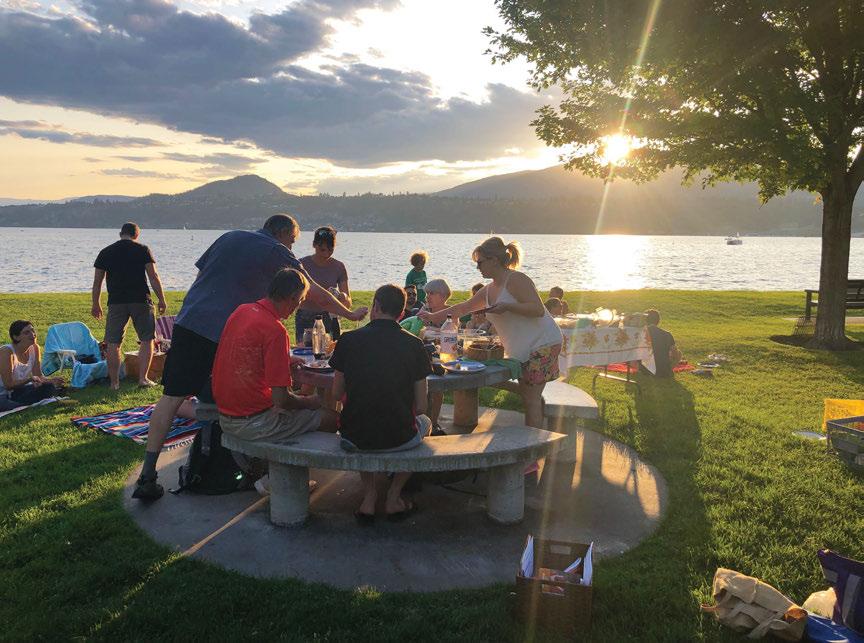

GREEN OKANAGAN, or GO for short, is a volunteer-led registered non-profit organization based in the beautiful Okanagan, in Canada. Our mandate is to progress sustainability from an individual level. By sharing our own experiences and easy to implement tips and tricks, we hope to empower you to make smart consumer choices and adapt your lifestyle to improve your overall sustainability.









We break it down in an approachable way, with simple and affordable solutions anyone can implement. Join our online community for free resources that’ll help you simplify your life and improve your sustainability.



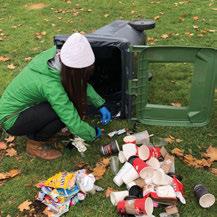






Local to the Okanagan?












Join us at our next event or workshopall are welcome in the GO community!


VISIT: WWW.GREENOKANAGAN.ORG FOR ALL THE DETAILS!








@GreenOkanagan@GreenOkanagan







www.greenokanagan.org






When we were in initial discussions about creating an organization and community movement, we were careful to consider the narrative we wanted to encourage. Climate change and its impacts can cause feelings of eco-anxiety or helplessness, which we wanted to acknowledge but also pivot from. We decided to take a solutions-forward approach, to educate and inspire our community.
“It’s important for people to be aware and understand the impact of the climate crisis, but we can’t stop there. Advocacy and execution are complementary, meaning we have to equip our communities with solutions they can implement for a more sustainable tomorrow. One way to achieve this is by creating a positive narrative that empowers people to take action.”
- Kayla Bruce, Assistant Director, Green OkanaganSolution: A main aspect of our organization is community involvement and education. We enjoy organizing and planning events to get in touch with locals and grow our sustainability-minded community. We host a wide range of events to cater to the various needs of our community audiences, and we serve as support for initiatives led by other organizations and businesses in the Okanagan.
• Sustainability Socials: GO’s Sustainability Socials are an opportunity to get people together to discuss sustainability topics, ideas, and issues. Hosted at a local venue, usually a restaurant or brewery, these gatherings include a TED Talk style presentation to encourage dialogue and flow of conversation among everyday environmentalists. Highlight topics have included Zero Waste Living, Perspectives of a Tesla Owner, and Sustainable Tourism, to name a few.
• Workshops: Hands-on engagement is a fun and effective method Green Okanagan uses to increase our community involvement. We have hosted multiple “do it yourself” style workshops that allow participants to learn, do, and take home items they have made to reduce their environmental impact. Our largest workshops include participants building their own vermi-compost for worm composting at home. These workshops teach attendees the ins and outs of low-waste living, all while guiding them through the construction, operation, and maintenance of their very own vermi-composting system complete with worms.
• Public Education Forums: We have hosted various events aimed at increasing public understanding of sustainability and its associated issues. In June 2019, GO hosted and facilitated Kelowna’s Town Hall Meeting for a Green New Deal with approximately 70 local participants. Students, local politicians, businesses owners, and others attended, demonstrating the broad reach our organization has built. Prior to the 2019 provincial election, Green Okanagan organized and hosted the 100 Debates on the Environment event for the local riding. The evening was dedicated to creating a space where local politicians and residents could interact regarding environmental issues. Any politically inspired event is kept non-partisan to ensure all opinions are heard and voiced. We encourage our community to get involved with local politics and vote for candidates that best align with their values.
• Presentations: Another way GO creates awareness about sustainability and plausible solutions is through presentations. Our hardworking volunteer team is comfortable presenting to a wide variety of audiences, having presented as speakers at lunch ‘n learns, conferences, as well as school assemblies.
Impact: Since forming in 2018, Green Okanagan has hosted over 50 local events and served as the designated Green Team for events like the SunRype Okanagan Marathon, the First Canadian Summit of Climate Action in Food Systems, and various initiatives with elementary, high school, and post-secondary institutions. Green Okanagan’s presence has grown from hosting these events and establishing key partnerships with local businesses, regional tourism associations, other NGOs, as well as schools ranging from elementary to college and university.
Creating Green Okanagan has been an incredibly rewarding and impactful experience but like with anything there have been lessons learned along the way. If you’re looking to create a community movement, consider these two points:
We’re very comfortable being busy and having an overflowing plate. We started Green Okanagan while still in school and working, which was a lot to balance already. Throw in founding and running an NGO and your schedule tends to fill up pretty quickly. We both wanted to support and grow the green movement in our community as best we could, but there were certainly times where it would have been okay to say “no” to opportunities.
Being recognized as environmental leaders in the community is an incredible acknowledgement, but that can also lead to a high volume of inquiries for your time and support. It’s important to remember your own personal capacity, as well as the capacity of your organization. It’s okay to say “no” some of the time, other opportunities will come up, and in the future, you may be positioned to better support them.
Volunteer retention is an area where many nonprofits and charities can face challenges. When balancing the priorities of life, school, work, and family, it’s understandable that volunteering may not be the top priority. Be aware and prepared that your organization may face volunteer turnover and brainstorm ways to improve retention rates and ride the wave when you find yourself shorthanded. For Green Okanagan, we have found that maintaining a small team of dedicated volunteers has allowed us to support our core operations and mandate. For events and larger initiatives that require additional support, we have a larger list of volunteers and community members we can reach out to who are looking for lower commitment opportunities.
By recognizing the gaps in your own community and developing a solutions-focused narrative, you have the power to create communitybased change through grassroots community involvement and education. Lastly, the journey to becoming a community leader is a road best travelled among friends. Find a support system, friend, club, or group of people you feel comfortable with and start the conversation. We both agree that we could not have achieved what we have with Green Okanagan if it were not for having each other. Find your tribe, it could be a tribe of two like in our case, and grow, build, and learn together.
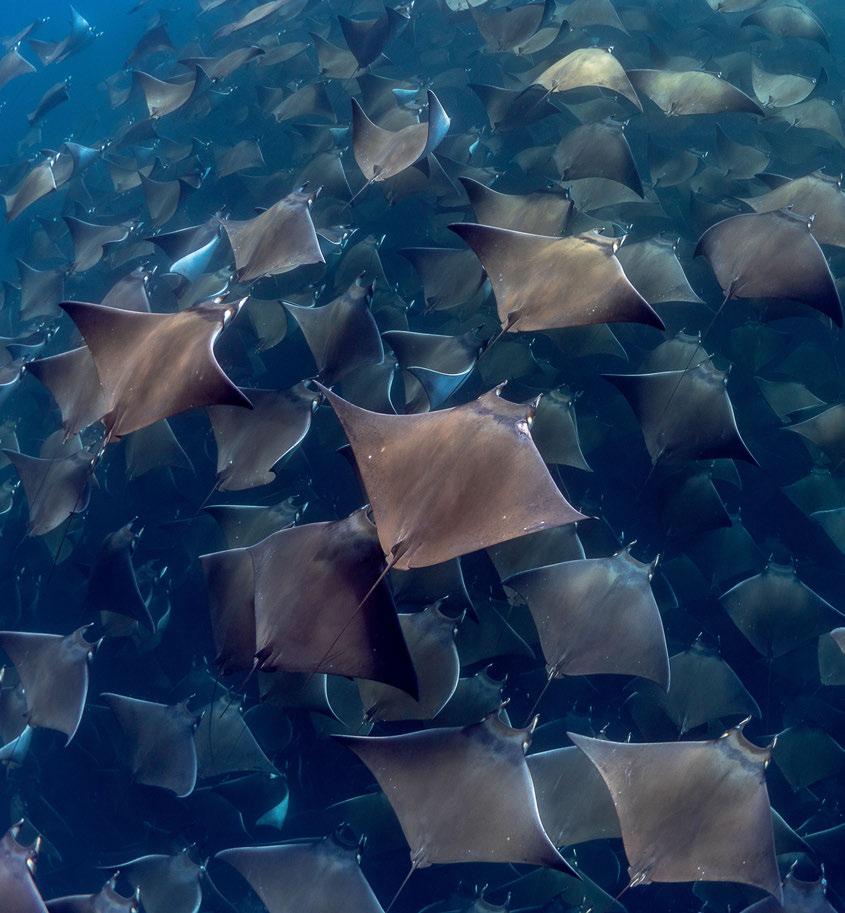
Come with us on an adventure to encounter the world’s most incredible marine life and experience some of the greatest spectacles of nature our planet has to offer. Or join one of our citizen science expeditions and trips to learn from esteemed marine scientists while assisting them on critical research. But best of all, know that you are supporting a true ecotourism platform. One that actively gives back and helps support the conservation, and protection, of our oceans and all of their remarkable inhabitants that make these beautiful experiences possible.
Scuba Diving


It’s not too late. You can help protect the last remaining ancient forests. Take action today at sierraclub.bc.ca/OldGrowth
